Paul van Yperen's Blog, page 337
August 11, 2016
EFSP's Dazzling Dozen: New from GDI
In the Dutch village of Noord-Scharwoude is a small but dynamic Filmmuseum, the Geoffrey Donaldson Institute (GDI). Director is our friend Egbert Barten who always shares his new postcard acquisitions with EFSP. His latest acquisition is a collection of postcards of female stars from the early 1960s. In colour or in black and white, from European and Hollywood stars, published in the Netherlands and in Germany - and one in Italy. Many were sent by mail to a film fan in the village of Helden in the south of the Netherlands. We selected 12 postcards to give an impression which film actresses dazzled a Dutch film fan in 1962.
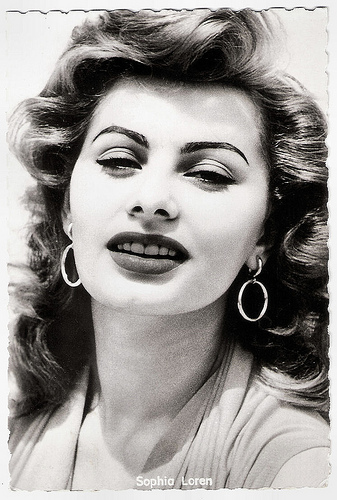
Sophia Loren . German postcard by Kolibri-Verlag G.m.b.H, Minden/Westf. Sent by mail in the Netherlands in 1962. Collection: Geoffrey Donaldson Institute.
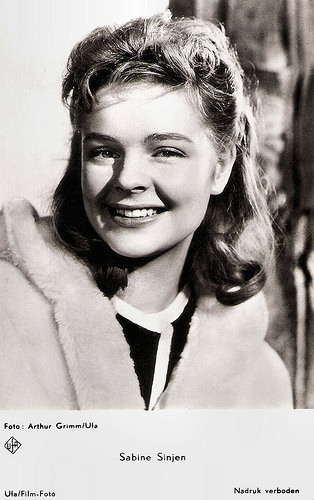
Sabine Sinjen . Dutch postcard by Gebr. Spanjersberg N.V., Rotterdam, no. 4788. Sent by mail in the Netherlands in 1962. Photo: Arthur Grimm / Ufa. Collection: Geoffrey Donaldson Institute.
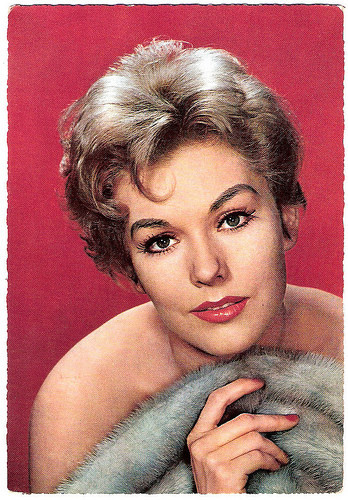
Kim Novak . German postcard by Krüger, no. 902/26. Sent by mail in the Netherlands in 1963. Collection: Geoffrey Donaldson Institute.
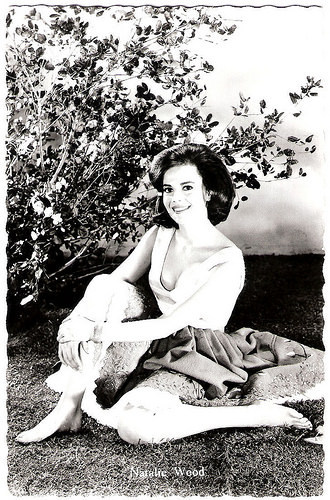
Natalie Wood. Dutch postcard. Sent by mail in the Netherlands in 1962. Publicity still for Splendor in the Grass (Elia Kazan, 1961). Collection: Geoffrey Donaldson Institute.
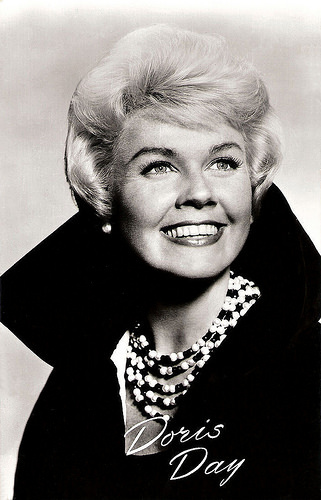
Doris Day. Dutch postcard by Uitg. Takken, Utrecht, no. AX 4240. Photo: Universal International. Publicity still for Pillow Talk (Michael Gordon, 1959). Collection: Geoffrey Donaldson Institute.
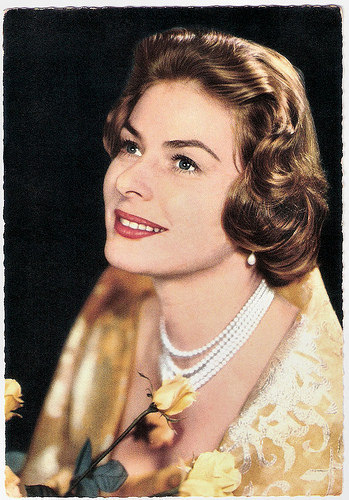
Ingrid Bergman . German postcard by ISV, no. H 21. Sent by mail in the Netherlands in 1962. Collection: Geoffrey Donaldson Institute.
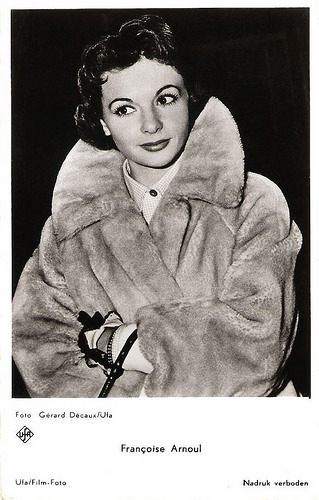
Françoise Arnoul . Dutch postcard by Gebr. Spanjersberg N.V., Rotterdam, no. 3318. Photo: Gérard Décaux / Ufa. Collection: Geoffrey Donaldson Institute.
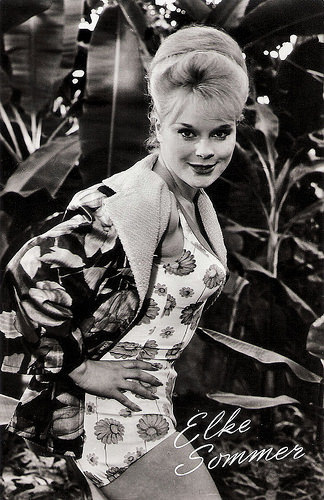
Elke Sommer . Dutch postcard by Uitg. Takken, Utrecht, no. AX 4982. Collection: Geoffrey Donaldson Institute.
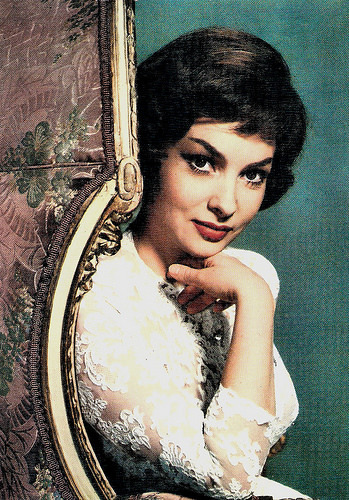
Gina Lollobrigida . Italian postcard by Rotalfoto, Milano, no. 93. Sent by mail in the Netherlands in 1962. Collection: Geoffrey Donaldson Institute.
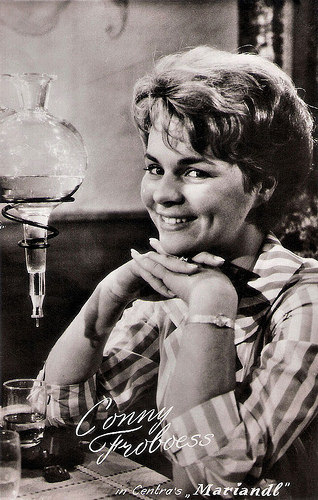
Conny Froboess . Dutch postcard by Takken, Utrecht, no. AX 4892. Photo: Centrafilm. Publicity still for Mariandl (Werner Jacobs, 1961). Collection: Geoffrey Donaldson Institute.
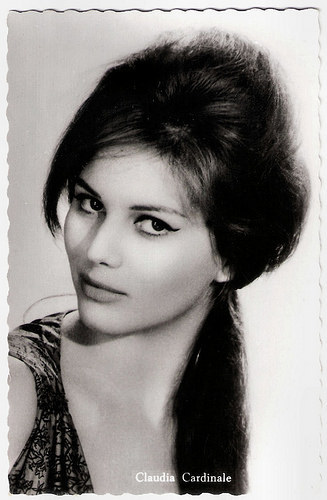
Claudia Cardinale . Dutch postcard. Collection: Geoffrey Donaldson Institute.
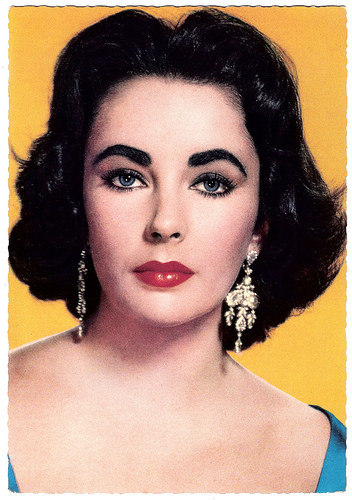
Elizabeth Taylor . German postcard by ISV, no. B 23. Photo: MGM. Publicity still for Cat on a Hot Tin Roof (Richard Brooks, 1958). Collection: Geoffrey Donaldson Institute.
Thanks, Egbert!
This is a post for Postcard Friendship Friday, hosted by Beth at the The Best Hearts are Crunchy. You can visit her by clicking on the button below.


Sophia Loren . German postcard by Kolibri-Verlag G.m.b.H, Minden/Westf. Sent by mail in the Netherlands in 1962. Collection: Geoffrey Donaldson Institute.

Sabine Sinjen . Dutch postcard by Gebr. Spanjersberg N.V., Rotterdam, no. 4788. Sent by mail in the Netherlands in 1962. Photo: Arthur Grimm / Ufa. Collection: Geoffrey Donaldson Institute.

Kim Novak . German postcard by Krüger, no. 902/26. Sent by mail in the Netherlands in 1963. Collection: Geoffrey Donaldson Institute.

Natalie Wood. Dutch postcard. Sent by mail in the Netherlands in 1962. Publicity still for Splendor in the Grass (Elia Kazan, 1961). Collection: Geoffrey Donaldson Institute.

Doris Day. Dutch postcard by Uitg. Takken, Utrecht, no. AX 4240. Photo: Universal International. Publicity still for Pillow Talk (Michael Gordon, 1959). Collection: Geoffrey Donaldson Institute.

Ingrid Bergman . German postcard by ISV, no. H 21. Sent by mail in the Netherlands in 1962. Collection: Geoffrey Donaldson Institute.

Françoise Arnoul . Dutch postcard by Gebr. Spanjersberg N.V., Rotterdam, no. 3318. Photo: Gérard Décaux / Ufa. Collection: Geoffrey Donaldson Institute.

Elke Sommer . Dutch postcard by Uitg. Takken, Utrecht, no. AX 4982. Collection: Geoffrey Donaldson Institute.

Gina Lollobrigida . Italian postcard by Rotalfoto, Milano, no. 93. Sent by mail in the Netherlands in 1962. Collection: Geoffrey Donaldson Institute.

Conny Froboess . Dutch postcard by Takken, Utrecht, no. AX 4892. Photo: Centrafilm. Publicity still for Mariandl (Werner Jacobs, 1961). Collection: Geoffrey Donaldson Institute.

Claudia Cardinale . Dutch postcard. Collection: Geoffrey Donaldson Institute.

Elizabeth Taylor . German postcard by ISV, no. B 23. Photo: MGM. Publicity still for Cat on a Hot Tin Roof (Richard Brooks, 1958). Collection: Geoffrey Donaldson Institute.
Thanks, Egbert!
This is a post for Postcard Friendship Friday, hosted by Beth at the The Best Hearts are Crunchy. You can visit her by clicking on the button below.

Published on August 11, 2016 22:00
August 10, 2016
Sabina Sesselmann
German actress Sabina (also: Sabine) Sesselmann (1936-1998) was the beautiful blonde leading lady of some 22 European films of the late 1950s and early 1960s. Next to her short but successful acting career, she was the cover girl of many popular magazines at the time.

German postcard by Kolibri-Verlag G.m.b.H., Minden/Westf, no. 753. Photo: Kolibri / Otfried Schmidt.

German postcard by Kolibri-Verlag G.m.b.H., Minden/Westf, no. 1112. Photo: Cinelux / Deutsche Cosmopol-Film (DCF) / Haenchen. Publicity still for Der Schatz im Toplitzsee/The Treasure in Toplitz Lake (Franz Antel, 1959).
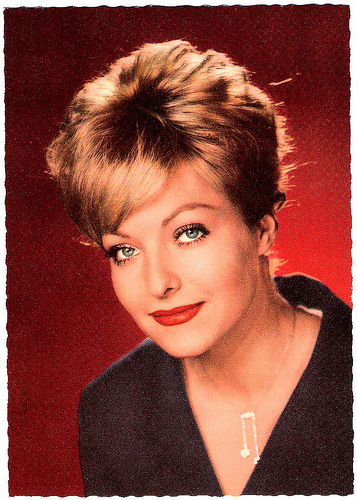
German postcard by Universum-Film Aktiengesellschaft (UFA), no. CK-285. Retail price: 30 Pfg. Photo: Sam Lévin / UFA.
Criminology Student Posing as a Prostitute
Sabina Traude Sesselmann was born in München (Munich), Germany in 1936. She was the daughter of a merchant. For a few years, she studied art history in Berlin, and then worked as a model to pay for ballet lessons and her training at the Reinhardt-school to become an actor.
She received her first engagement at the Lübecker Theater in 1957. That year she also did her first film appearance as a fairy godmother in the children’s film Aufruhr im Schlaraffenland/Trouble in the Land of Milk and Honey (Otto Meyer, 1957).
In quick succession she stood in various productions for the camera, such as Liebe kann wie Gift sein/Love Can Be Poison (Veit Harlan, 1958) opposite Joachim Fuchsberger , and the World War II-film U47 - Kapitänleutnant Prien/U-47 Lt. Commander Prien (Harald Reinl, 1958) as the wife of the title figure played by Dieter Eppler.
Her breakthrough role was that of a criminology student who poses as a prostitute to conduct first-hand research on her thesis paper, and then saves a victim of a racket in the crime drama Madeleine Tel. 13 62 11/ Naked in the Night (Kurt Meisel, 1958) starring Eva Bartok .
The following year she played a supporting part in the excellent war drama Kriegsgericht/Court Martial (Kurt Meisel, 1959) starring Karlheinz Böhm and Christian Wolff . She also appeared in the Schlager musical Freddy, die Gitarre und das Meer/Freddy, the Guitar and the Sea (Wolfgang Schleif, 1959) with Freddy Quinn .
As Sabina Selman she played the female lead in the French Swashbuckler Le Bossu/The Hunchback (André Hunebelle, 1959) starring Jean Marais and Bourvil . And that same year she was Joachim Hansen ’s fiancée in the Der Schatz vom Toplitzsee/The Treasure of Toplitzsee (Franz Antel, 1959).
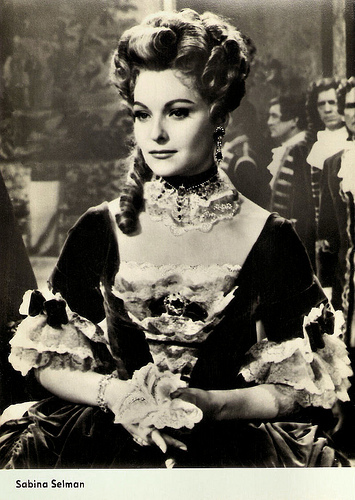
East-German postcard by VEB Progress Filmvertrieb, no. 1598. Photo: publicity still for Le Bossu/The Yokel (André Hunebelle, 1959).
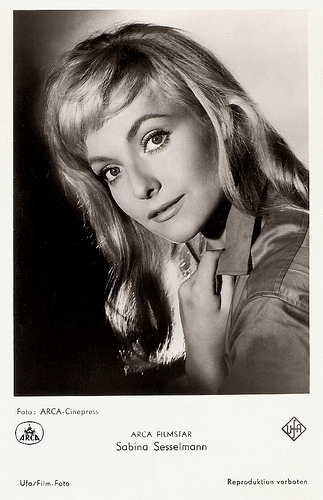
German postcard by Universum-Film Aktiengesellschaft (Ufa), Berlin-Tempelhof, no. 4416. Retail price: 25 Pfg. Photo: Arca / Cinepress.
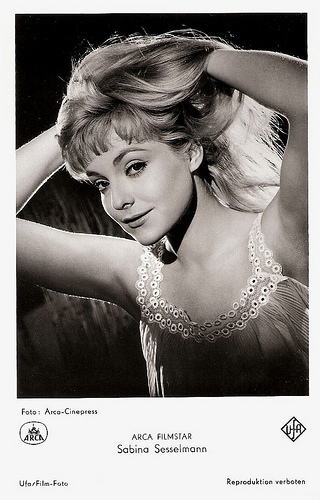
German postcard by Universum-Film Aktiengesellschaft (Ufa), Berlin-Tempelhof, no. FK 4050. Retail price: 25 Pfg. Photo: Arca / Cinepress. Publicity still for Liebe kann wie Gift sein (Veit Harlan, 1958).
Trite to the Point of Silliness
In the 1960s, Sabina Sesselmann continued to play in German language productions. She was the star of the Swiss comedy Der Herr mit der schwarzen Melone/The Man in the Black Derby (Karl Suter, 1960) with Gustav Knuth. She appeared opposite Hannes Messemer in the German crime drama Die Brücke des Schicksals/The Bridge of Destiny (Michael Kehlmann, 1960).
Often she played in such Edgar Wallace thrillers as Das Geheimnis der gelben Narzissen/The Devil's Daffodil (Ákos Ráthonyi, 1961) and Die Tür mit den sieben Schlössern/The Door with Seven Locks (Alfred Vohrer, 1962) with Heinz Drache. The first one was a German-British coproduction that was made in two alternative language versions.
She also appeared in the American crime movie Information Received (Robert Lynn, 1961). The next year she starred with Adrian Hoven in the popular TV series Alarm für Dora X (Mohr von Chamier, 1962).
After that, she appeared in only two more films: the Austrian comedy Rote Lippen soll man küssen/Red Lips Should Be Kissed (Franz Antel, 1963) starring Johanna Matz and Peter Weck , and the drama Ein Sarg aus Hongkong/Coffin from Hong Kong (Manfred R. Köhler, 1964) with Heinz Drache.
At IMDb , Quanche comments: “this was one of a whole series of relatively low budget German noir/espionage/thriller type films made in the early to mid sixties. Although the scripting of these films is often trite to the point of silliness, they are generally well acted, and usually set (though not filmed) someplace other than Germany, usually London or the U.S.”
In 1964, Sabina Sesselmann secretly married Mercedes dealer Ernst Henne Jr., the son of legendary motor racer and multi-millionaire Ernst Jakob Henne. After that, she retired more or less from the public.
Five years later she played a guest-role in the TV series Luftsprünge/Jumps in the Air (Hermann Leitner, Ernst Schmucker, 1969) with Luis Trenker and Toni Sailer . And in 1996, she did one final appearance in an episode of the popular Krimi series SOKO 5113 (1978-).
Two years later, Sabina Sesselmann passed away in Tutzing. At 61, she had succumbed to cancer.

Vintage postcard.
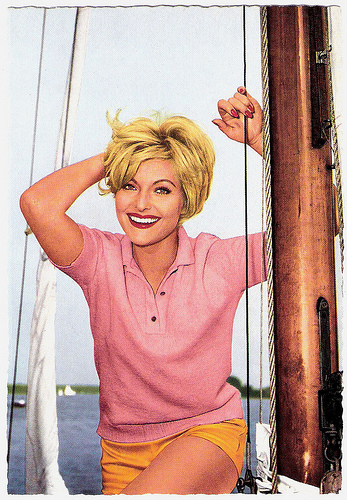
German postcard by WS-Druck, Wanne-Eickel, no. F 166.
Sources: Stephanie D’heil (Steffi-line) (German), AllMovie, Filmportal.de, Wikipedia (German), and .

German postcard by Kolibri-Verlag G.m.b.H., Minden/Westf, no. 753. Photo: Kolibri / Otfried Schmidt.

German postcard by Kolibri-Verlag G.m.b.H., Minden/Westf, no. 1112. Photo: Cinelux / Deutsche Cosmopol-Film (DCF) / Haenchen. Publicity still for Der Schatz im Toplitzsee/The Treasure in Toplitz Lake (Franz Antel, 1959).

German postcard by Universum-Film Aktiengesellschaft (UFA), no. CK-285. Retail price: 30 Pfg. Photo: Sam Lévin / UFA.
Criminology Student Posing as a Prostitute
Sabina Traude Sesselmann was born in München (Munich), Germany in 1936. She was the daughter of a merchant. For a few years, she studied art history in Berlin, and then worked as a model to pay for ballet lessons and her training at the Reinhardt-school to become an actor.
She received her first engagement at the Lübecker Theater in 1957. That year she also did her first film appearance as a fairy godmother in the children’s film Aufruhr im Schlaraffenland/Trouble in the Land of Milk and Honey (Otto Meyer, 1957).
In quick succession she stood in various productions for the camera, such as Liebe kann wie Gift sein/Love Can Be Poison (Veit Harlan, 1958) opposite Joachim Fuchsberger , and the World War II-film U47 - Kapitänleutnant Prien/U-47 Lt. Commander Prien (Harald Reinl, 1958) as the wife of the title figure played by Dieter Eppler.
Her breakthrough role was that of a criminology student who poses as a prostitute to conduct first-hand research on her thesis paper, and then saves a victim of a racket in the crime drama Madeleine Tel. 13 62 11/ Naked in the Night (Kurt Meisel, 1958) starring Eva Bartok .
The following year she played a supporting part in the excellent war drama Kriegsgericht/Court Martial (Kurt Meisel, 1959) starring Karlheinz Böhm and Christian Wolff . She also appeared in the Schlager musical Freddy, die Gitarre und das Meer/Freddy, the Guitar and the Sea (Wolfgang Schleif, 1959) with Freddy Quinn .
As Sabina Selman she played the female lead in the French Swashbuckler Le Bossu/The Hunchback (André Hunebelle, 1959) starring Jean Marais and Bourvil . And that same year she was Joachim Hansen ’s fiancée in the Der Schatz vom Toplitzsee/The Treasure of Toplitzsee (Franz Antel, 1959).

East-German postcard by VEB Progress Filmvertrieb, no. 1598. Photo: publicity still for Le Bossu/The Yokel (André Hunebelle, 1959).

German postcard by Universum-Film Aktiengesellschaft (Ufa), Berlin-Tempelhof, no. 4416. Retail price: 25 Pfg. Photo: Arca / Cinepress.

German postcard by Universum-Film Aktiengesellschaft (Ufa), Berlin-Tempelhof, no. FK 4050. Retail price: 25 Pfg. Photo: Arca / Cinepress. Publicity still for Liebe kann wie Gift sein (Veit Harlan, 1958).
Trite to the Point of Silliness
In the 1960s, Sabina Sesselmann continued to play in German language productions. She was the star of the Swiss comedy Der Herr mit der schwarzen Melone/The Man in the Black Derby (Karl Suter, 1960) with Gustav Knuth. She appeared opposite Hannes Messemer in the German crime drama Die Brücke des Schicksals/The Bridge of Destiny (Michael Kehlmann, 1960).
Often she played in such Edgar Wallace thrillers as Das Geheimnis der gelben Narzissen/The Devil's Daffodil (Ákos Ráthonyi, 1961) and Die Tür mit den sieben Schlössern/The Door with Seven Locks (Alfred Vohrer, 1962) with Heinz Drache. The first one was a German-British coproduction that was made in two alternative language versions.
She also appeared in the American crime movie Information Received (Robert Lynn, 1961). The next year she starred with Adrian Hoven in the popular TV series Alarm für Dora X (Mohr von Chamier, 1962).
After that, she appeared in only two more films: the Austrian comedy Rote Lippen soll man küssen/Red Lips Should Be Kissed (Franz Antel, 1963) starring Johanna Matz and Peter Weck , and the drama Ein Sarg aus Hongkong/Coffin from Hong Kong (Manfred R. Köhler, 1964) with Heinz Drache.
At IMDb , Quanche comments: “this was one of a whole series of relatively low budget German noir/espionage/thriller type films made in the early to mid sixties. Although the scripting of these films is often trite to the point of silliness, they are generally well acted, and usually set (though not filmed) someplace other than Germany, usually London or the U.S.”
In 1964, Sabina Sesselmann secretly married Mercedes dealer Ernst Henne Jr., the son of legendary motor racer and multi-millionaire Ernst Jakob Henne. After that, she retired more or less from the public.
Five years later she played a guest-role in the TV series Luftsprünge/Jumps in the Air (Hermann Leitner, Ernst Schmucker, 1969) with Luis Trenker and Toni Sailer . And in 1996, she did one final appearance in an episode of the popular Krimi series SOKO 5113 (1978-).
Two years later, Sabina Sesselmann passed away in Tutzing. At 61, she had succumbed to cancer.

Vintage postcard.

German postcard by WS-Druck, Wanne-Eickel, no. F 166.
Sources: Stephanie D’heil (Steffi-line) (German), AllMovie, Filmportal.de, Wikipedia (German), and .
Published on August 10, 2016 22:00
August 9, 2016
I promessi sposi (1941)
I promessi sposi/The Spirit and the Flesh (Mario Camerini, 1941) is sometimes called the Italian Gone With the Wind (Victor Fleming, 1939). It's a lavishly produced historical love story, set against a turbulent social background of war. Stars of the film are Gino Cervi and Dina Sassoli. The latter was found after a well publicised competition for the lead role, yes, just like how David O. Selznick found Vivien Leigh for Gone With the Wind.
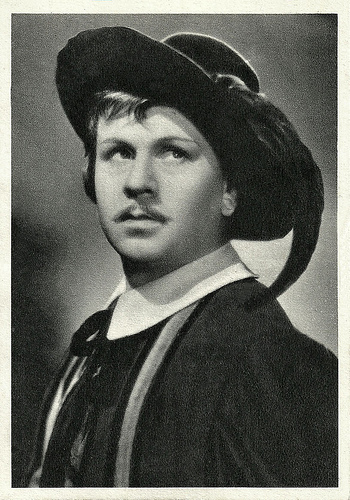
Italian postcard by S.A. Grafitalia, Milano (Milan), no. 10. Photo: Film Lux. Publicity still for I Promessi Sposi/The Spirit and the Flesh (Mario Camerini, 1941). Gino Cervi as Renzo Tramaglino.
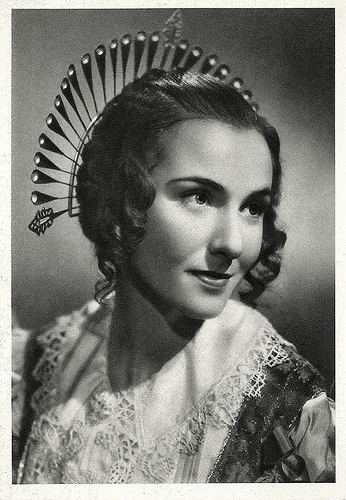
Italian postcard by S.A. Grafitalia, Milano (Milan), no. 10. Photo: Film Lux. Publicity still for I Promessi Sposi/The Spirit and the Flesh (Mario Camerini, 1941) with Dina Sassoli as Lucia Mondella.
A Love Story Jeopardised
Alessandro Manzoni's novel I promessi sposi (The Betrothed) is to Italian literature what Leo Tolstoy's War and Peace is to Russian literature. This Italian historical novel, set in Lumbardy, Italy, in the seventeenth century, belongs to the most famous and widely read books of the Italian language.
The two betrothed are Renzo and Lucia. Their love story is jeopardised by Don Rodrigo, the lord of the domain, who is infatuated with Lucia. When she refuses his attentions he has her kidnapped. The priest Don Abbondio, comes to the assistance of the two as does a godly brother, Cristoforo. The character called l'Innominato or 'the unnamed' is sent by Don Rodrigo to abduct the girl and give her once and for all to Don Rodrigo, but in a startling change of heart, he undergoes a religious conversion and does the right thing by liberating her. Brother Cristoforo frees her also from her vow of chastity she had made in the hope of being relinquished from the clutches of the Innominato. But Lucia's tribulations are not over yet...
Manzoni's novel has been filmed several times, including an early silent version by the Ambrosio company, I promessi sposi/The Betrothed (Eleuterio Rodolfi, 1913), about which we earlier did a post on EFSP . Nine years later followed another silent adaptation: I promessi sposi (Mario Bonnard, 1922).
Our post today is about the first sound version, I promessi sposi (Mario Camerinni, 1941) with the English title The Spirit and the Flesh. This production was a lavish affair for its time. After the Camerini adaptation followed a Spanish-Italian version I Promessi Sposi (Mario Maffei, 1964), starring Gil Vidal and Maria Silva as Renzo and Lucia.
There were also various television versions. In 1967 Nino Castelnuovo starred as Renzo in the TV series I promessi sposi (Sandro Bolchi, 1967). Later followed a 9-hour adaptation for Italian TV I promessi sposi (Salvatore Nocita, 1989), which featured an all-star cast including Danny Quinn, Alberto Sordi , Franco Nero , F. Murray Abraham, Burt Lancaster , Helmut Berger , Valentina Cortese and Fernando Rey. Finally there was the TV film Renzo e Lucia/Renzo and Lucia (Francesca Archibugi, 2004) with Stefania Sandrelli as Agnese, Laura Morante as the Nun of Monza and Gottfried John as the Innominato.
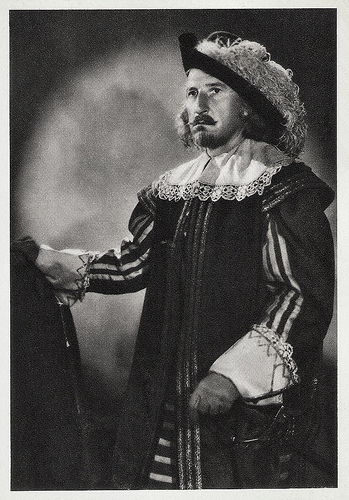
Italian postcard by S.A. Grafitalia, Milano (Milan), no. 10. Photo: Film Lux. Publicity still for I Promessi Sposi/The Spirit and the Flesh (Mario Camerini, 1941) with Carlo Ninchi as L'Innominato.
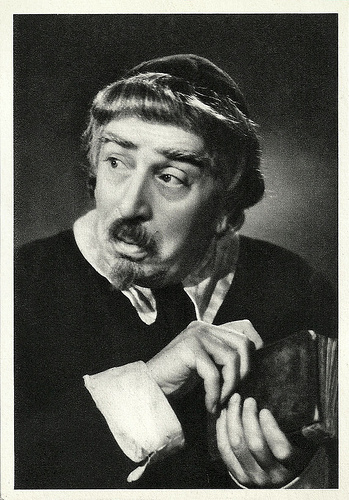
Italian postcard by S.A. Grafitalia, Milano (Milan), no. 10. Photo: Film Lux. Publicity still for I Promessi Sposi/The Spirit and the Flesh (Mario Camerini, 1941). Armando Falconi as Don Abbondio.
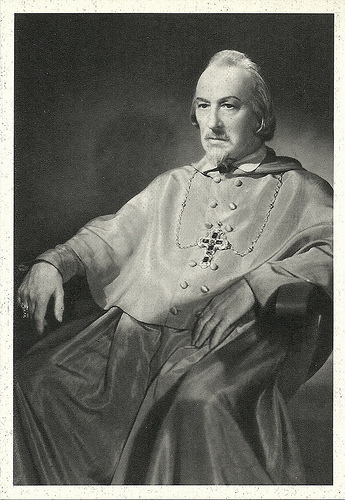
Italian postcard by S.A. Grafitalia, Milano (Milan), no. 10. Photo: Film Lux. Publicity still for I Promessi Sposi/The Spirit and the Flesh (Mario Camerini, 1941). Ruggero Ruggeri as Cardinal Federigo Borromeo.
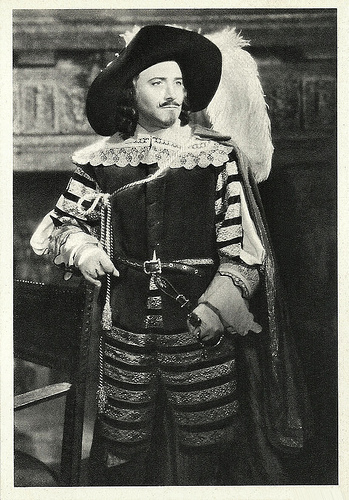
Italian postcard by S.A. Grafitalia, Milano (Milan), no. 10. Photo: Film Lux. Publicity still for I Promessi Sposi/The Spirit and the Flesh (Mario Camerini, 1941). Enrico Glori as Don Rodrigo.
An Outbreak of Pestilence and a Miracle
I Promessi Sposi/The Spirit and the Flesh (1941) was directed by Mario Camerini, who began his long career already in the silent era. He is probably best known for his Telefoni Bianchi films of the 1930s, the typical Italian sophisticated 'white telephone' comedies, starring Vittorio De Sica . Camerini later directed the enjoyable international film version of Ulisse/Ulysses (Mario Camerini, 1954) with Kirk Douglas and Silvana Mangano .
Camerini did a good job on I Promessi Sposi. The director himself wrote the screenplay and according to Mario Gauci at IMDb , Camerini brought the elaborate plot "meticulously to life and the good performances enhance the film's every mood through romance, drama, comedy and action."
However contemporary reviews complained that the film was compromised by a too-condensed second half, although the film's length is nearly 2 hours. There are numerous characters and the story is set in several cities over a period of years, covers court intrigues, the persecution of two lovers, the renunciation of love, an outbreak of pestilence and culminates in a miracle. It's all set against a turbulent social background of war that makes the film a kind of Italian Gone with the Wind.
Leading man is Gino Cervi , best-known as the Communist antagonist to Fernandel's Don Camillo in the popular comedy series of the 1950s. Here he is a young and handsome hero, worlds apart from mayor Peppone.
The female lead was played by Dina Sassoli. The film's producers had organised a competition to select the lead actress which was modelled on the hunt for Scarlett O'Hara by the American producer David O. Selznick for Gone With the Wind. The film made a star of Sassoli and she would have a long career.
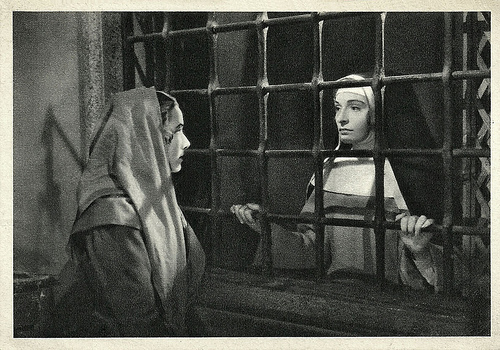
Italian postcard by S.A. Grafitalia, Milano (Milan), no. 10. Photo: Film Lux. Publicity still for I Promessi Sposi/The Spirit and the Flesh (Mario Camerini, 1941). Dina Sassoli as Lucia Mondella and Eva Maltagliati as the Nun of Monza.
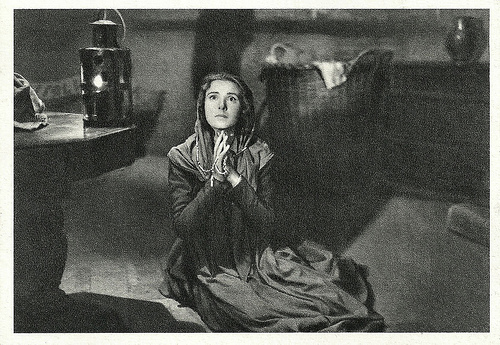
Italian postcard by S.A. Grafitalia, Milano (Milan), no. 10. Photo: Film Lux. Publicity still for I Promessi Sposi/The Spirit and the Flesh (Mario Camerini, 1941). Dina Sassoli as Lucia Mondella.

Italian postcard by S.A. Grafitalia, Milano (Milan), no. 10. Photo: Film Lux. Publicity still for I Promessi Sposi/The Spirit and the Flesh (Mario Camerini, 1941) with Gino Cervi as Renzo.
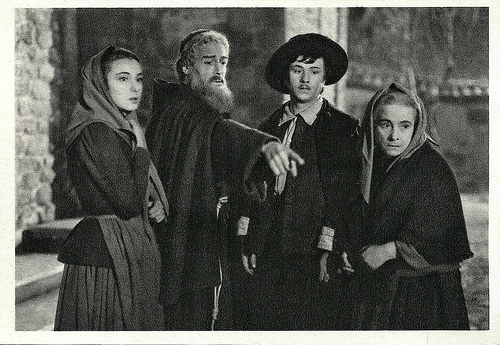
Italian postcard by S.A. Grafitalia, Milano (Milan), no. 10. Photo: Film Lux. Publicity still for I Promessi Sposi/The Spirit and the Flesh (Mario Camerini, 1941). Dina Sassoli (Lucia), Luis Hurtado (Fra' Cristoforo), Gino Cervi (Renzo), and Gilda Marchiò (Agnese, Lucia's mother).
Sources: Gerald A. DeLuca (IMDb), Mario Gauci (IMDb), Wikipedia and IMDb.

Italian postcard by S.A. Grafitalia, Milano (Milan), no. 10. Photo: Film Lux. Publicity still for I Promessi Sposi/The Spirit and the Flesh (Mario Camerini, 1941). Gino Cervi as Renzo Tramaglino.

Italian postcard by S.A. Grafitalia, Milano (Milan), no. 10. Photo: Film Lux. Publicity still for I Promessi Sposi/The Spirit and the Flesh (Mario Camerini, 1941) with Dina Sassoli as Lucia Mondella.
A Love Story Jeopardised
Alessandro Manzoni's novel I promessi sposi (The Betrothed) is to Italian literature what Leo Tolstoy's War and Peace is to Russian literature. This Italian historical novel, set in Lumbardy, Italy, in the seventeenth century, belongs to the most famous and widely read books of the Italian language.
The two betrothed are Renzo and Lucia. Their love story is jeopardised by Don Rodrigo, the lord of the domain, who is infatuated with Lucia. When she refuses his attentions he has her kidnapped. The priest Don Abbondio, comes to the assistance of the two as does a godly brother, Cristoforo. The character called l'Innominato or 'the unnamed' is sent by Don Rodrigo to abduct the girl and give her once and for all to Don Rodrigo, but in a startling change of heart, he undergoes a religious conversion and does the right thing by liberating her. Brother Cristoforo frees her also from her vow of chastity she had made in the hope of being relinquished from the clutches of the Innominato. But Lucia's tribulations are not over yet...
Manzoni's novel has been filmed several times, including an early silent version by the Ambrosio company, I promessi sposi/The Betrothed (Eleuterio Rodolfi, 1913), about which we earlier did a post on EFSP . Nine years later followed another silent adaptation: I promessi sposi (Mario Bonnard, 1922).
Our post today is about the first sound version, I promessi sposi (Mario Camerinni, 1941) with the English title The Spirit and the Flesh. This production was a lavish affair for its time. After the Camerini adaptation followed a Spanish-Italian version I Promessi Sposi (Mario Maffei, 1964), starring Gil Vidal and Maria Silva as Renzo and Lucia.
There were also various television versions. In 1967 Nino Castelnuovo starred as Renzo in the TV series I promessi sposi (Sandro Bolchi, 1967). Later followed a 9-hour adaptation for Italian TV I promessi sposi (Salvatore Nocita, 1989), which featured an all-star cast including Danny Quinn, Alberto Sordi , Franco Nero , F. Murray Abraham, Burt Lancaster , Helmut Berger , Valentina Cortese and Fernando Rey. Finally there was the TV film Renzo e Lucia/Renzo and Lucia (Francesca Archibugi, 2004) with Stefania Sandrelli as Agnese, Laura Morante as the Nun of Monza and Gottfried John as the Innominato.

Italian postcard by S.A. Grafitalia, Milano (Milan), no. 10. Photo: Film Lux. Publicity still for I Promessi Sposi/The Spirit and the Flesh (Mario Camerini, 1941) with Carlo Ninchi as L'Innominato.

Italian postcard by S.A. Grafitalia, Milano (Milan), no. 10. Photo: Film Lux. Publicity still for I Promessi Sposi/The Spirit and the Flesh (Mario Camerini, 1941). Armando Falconi as Don Abbondio.

Italian postcard by S.A. Grafitalia, Milano (Milan), no. 10. Photo: Film Lux. Publicity still for I Promessi Sposi/The Spirit and the Flesh (Mario Camerini, 1941). Ruggero Ruggeri as Cardinal Federigo Borromeo.

Italian postcard by S.A. Grafitalia, Milano (Milan), no. 10. Photo: Film Lux. Publicity still for I Promessi Sposi/The Spirit and the Flesh (Mario Camerini, 1941). Enrico Glori as Don Rodrigo.
An Outbreak of Pestilence and a Miracle
I Promessi Sposi/The Spirit and the Flesh (1941) was directed by Mario Camerini, who began his long career already in the silent era. He is probably best known for his Telefoni Bianchi films of the 1930s, the typical Italian sophisticated 'white telephone' comedies, starring Vittorio De Sica . Camerini later directed the enjoyable international film version of Ulisse/Ulysses (Mario Camerini, 1954) with Kirk Douglas and Silvana Mangano .
Camerini did a good job on I Promessi Sposi. The director himself wrote the screenplay and according to Mario Gauci at IMDb , Camerini brought the elaborate plot "meticulously to life and the good performances enhance the film's every mood through romance, drama, comedy and action."
However contemporary reviews complained that the film was compromised by a too-condensed second half, although the film's length is nearly 2 hours. There are numerous characters and the story is set in several cities over a period of years, covers court intrigues, the persecution of two lovers, the renunciation of love, an outbreak of pestilence and culminates in a miracle. It's all set against a turbulent social background of war that makes the film a kind of Italian Gone with the Wind.
Leading man is Gino Cervi , best-known as the Communist antagonist to Fernandel's Don Camillo in the popular comedy series of the 1950s. Here he is a young and handsome hero, worlds apart from mayor Peppone.
The female lead was played by Dina Sassoli. The film's producers had organised a competition to select the lead actress which was modelled on the hunt for Scarlett O'Hara by the American producer David O. Selznick for Gone With the Wind. The film made a star of Sassoli and she would have a long career.

Italian postcard by S.A. Grafitalia, Milano (Milan), no. 10. Photo: Film Lux. Publicity still for I Promessi Sposi/The Spirit and the Flesh (Mario Camerini, 1941). Dina Sassoli as Lucia Mondella and Eva Maltagliati as the Nun of Monza.

Italian postcard by S.A. Grafitalia, Milano (Milan), no. 10. Photo: Film Lux. Publicity still for I Promessi Sposi/The Spirit and the Flesh (Mario Camerini, 1941). Dina Sassoli as Lucia Mondella.

Italian postcard by S.A. Grafitalia, Milano (Milan), no. 10. Photo: Film Lux. Publicity still for I Promessi Sposi/The Spirit and the Flesh (Mario Camerini, 1941) with Gino Cervi as Renzo.

Italian postcard by S.A. Grafitalia, Milano (Milan), no. 10. Photo: Film Lux. Publicity still for I Promessi Sposi/The Spirit and the Flesh (Mario Camerini, 1941). Dina Sassoli (Lucia), Luis Hurtado (Fra' Cristoforo), Gino Cervi (Renzo), and Gilda Marchiò (Agnese, Lucia's mother).
Sources: Gerald A. DeLuca (IMDb), Mario Gauci (IMDb), Wikipedia and IMDb.
Published on August 09, 2016 22:00
August 8, 2016
Ernst Verebes
Hungarian actor Ernst (or Ernö) Verebes (1902-1971) was a popular and elegant matinee idol of the German cinema in the silent and early sound period. Sadly his career was broken by the Nazis.
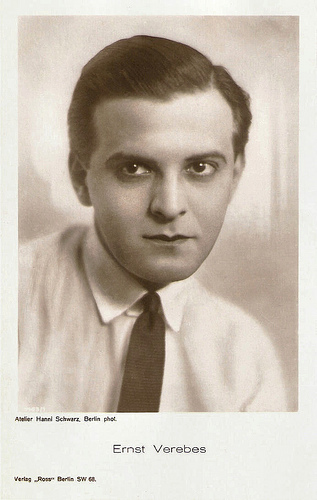
German postcard by Ross Verlag, no. 1483/1, 1926-1927. Photo: Hanni Schwarz, Berlin.

German postcard by Ross Verlag, no. 1782/2, 1926-1927. Photo: Alex Binder.

German postcard by Ross Verlag, no. 3507/1, 1928-1929. Photo: Atelier Hanni Schwarz, Berlin.
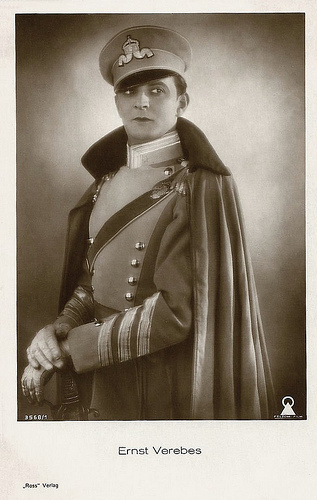
German postcard by Ross Verlag, no. 3568/1, 1928-1929. Photo: Felsom-Film. Publicity still for Der fesche Husar (Geza von Bolvary, 1929).
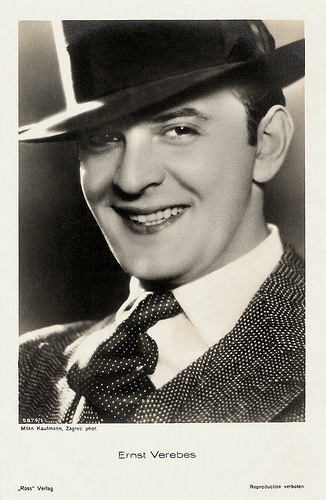
German postcard by Ross Verlag, no. 5874/1, 1930-1931. Photo: Milan Kaufmann, Zagreb.
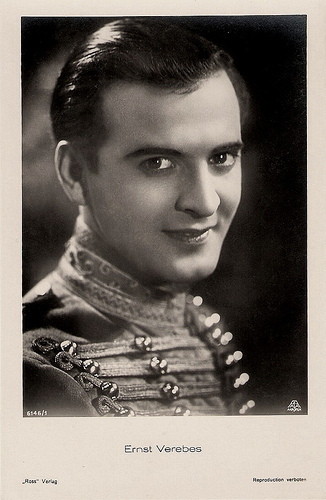
German postcard by Ross Verlag, no. 6146/1, 1931-1932. Photo: Aafa Film.
Hungary
Ernst Verebes was born as Ernö Verebes in New York in 1902. In 1914 his family returned to Hungary and there his film career began with Mire megvénülünk/The Seventh Veil (Ödön Uher ifj., 1917) and the Charles Dickens adaptation Twist Olivér/Oliver Twist (Márton Garas, 1919).
In the 1920s he appeared in such Hungarian films as A hetedik Fatyol (János Vanicsek, 1922), A Pál-utcai fiúk (Béla Balogh, 1924) based on a novel by Ferenc Molnár, and Holnap kezdödik az élet (Antal Forgács, 1924) with Maria Corda .
From 1925 on he became established as Ernst Verebes in the German film industry. He appeared in such films as Der Mann im Sattel/The Man in the Saddle (Manfred Noa, 1925), Gräfin Mariza/Countess Mariza (Hans Steinhoff, 1925), and Qualen der Nacht/Torments of the Night (Kurt Bernhardt/Curtis Bernhardt, 1926) with Claire Rommer .
Guy Bellinger at IMDb writes: "he was one of those manly actors, both well-built and charming, at ease as well in a military uniform as in a tuxedo and top hat, that German ladies loved to see on a big screen." Many more films followed, including Bigamie/Bigamy (Jaap Speyer, 1927) starring Heinrich George , Der Geisterzug/Ghost Train (Géza von Bolvary, 1927), Der Bettelstudent/The Beggar Student (Jacob Fleck, Luise Fleck, 1927) with Harry Liedtke .
Verebes appeared as a count opposite Lya Mara in Der Zigeunerbaron/The Gypsy Baron (Friedrich Zelnik aka Frederic Zelnik, 1927), and starred in Das Land ohne Frauen/Bride Number 68 (Carmine Gallone, 1929). Incidentally he also made Hungarian films like A Pál-utcai fúk/Paul Street Boys (Bela Balogh, 1929), based on a novel by Ferenc Molnar.
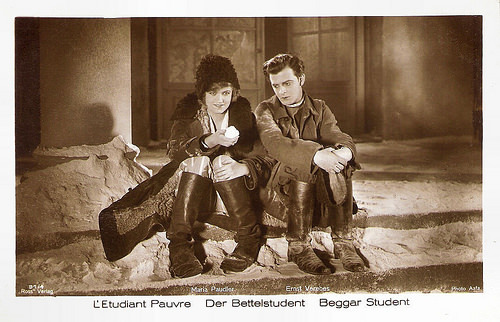
German postcard by Ross Verlag, no. 91/4. Photo: Aafa Film. Publicity still for Der Bettelstudent/The Beggar Student (Jacob Fleck, Luise Fleck, 1927) with Maria Paudler.
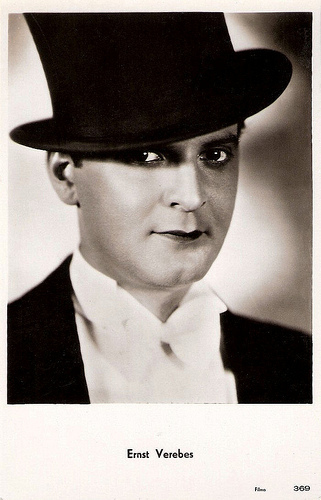
Dutch postcard by Filma, no. 369.
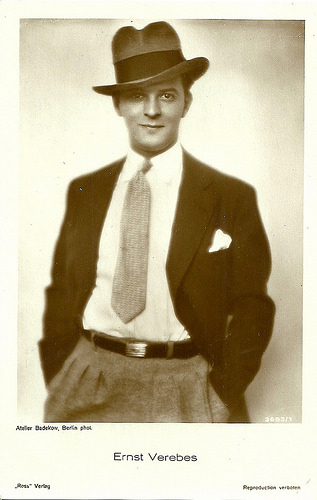
German postcard by Ross Verlag, no. 3693/1, 1928-1929. Photo: Atelier Badekow, Berlin.
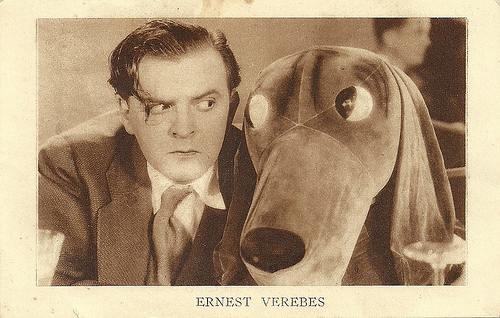
Belgian postcard. by S.A. Cacao et Chocolat Kivou, Vilvo[o]rde, Belgium. For either a late silent or early sound film.
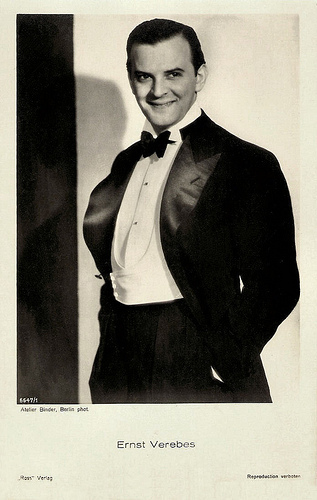
German postcard by Ross Verlag, no. 6647/1, 1931-1932. Photo: Atelier Binder, Berlin.
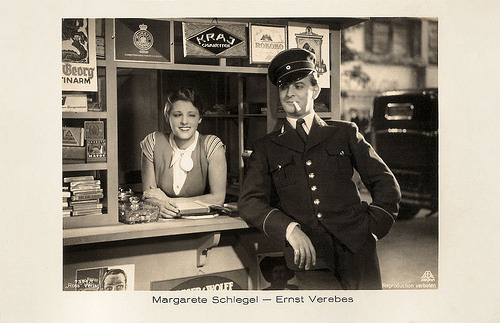
German postcard by Ross Verlag, no. 7394/1, 1932-1933. Photo: Aafa Film. Publicity still for Das blaue vom Himmel/The Blue from the Sky (Victor Janson, 1932) with Margarete Schlegel.
Germany and Hollywood
The German public acclaimed Ernst Verebes, especially in roles in uniform, such as the dashing hussar lieutenant in Der Tanzhusar/The Dancing Hussar (Fred Sauer, 1931) with Gretl Theimer . In the early 1930s he appeared in a whole string of German films including Va Banque (Erich Waschneck, 1930) starring Lil Dagover , Viktoria und ihr Husar/Victoria and Her Hussar (Richard Oswald, 1931), Die verliebte Firma/The Company's in Love (Max Ophüls, 1932), and Es wird schon wieder besser/Things Are Getting Better Already (Kurt Gerron, 1932) starring Dolly Haas and Heinz Rühmann .
Verebes was not desired by the Nazis and he moved to Austria where he appeared in Katharina die Letzte/Catherine the Last (Henry Koster, 1935) featuring Franciska Gaál . After the Anschluss of Austria to Nazi-Germany in 1936 Verebes decided to flee again and to take refuge in the US.
His career resumed there two years later but his matinee idol years were over. Verebes, now named Ernö again, first found a few acceptable supporting roles, mainly as the German or SS officer in office. He was seen in such films as A Desperate Adventure (John H. Auer, 1938) starring Ramon Novarro , Balalaika (Reinhold Schünzel, 1939), and The Hitler Gang (John Farrow, 1944). He is particularly memorable in a non military part, as the stage manager in Ernst Lubitsch 's classic To Be or Not To Be (Ernst Lubitsch, 1942).
After World War Two, he was only given bit parts to play. Guy Bellinger at IMDb : "a far cry from the star status he benefited from only one or two decades earlier. The strange thing is that, whatever the type a film he was in, he was most of the time cast as a ... waiter! For years on, in at least fifteen movies, he would serve drinks to actors and actresses lucky enough to have something interesting to play. Sure there were variants, Ernö Verebes could be a bartender, a head waiter, a wine steward or the captain of waiters but the former popular and elegant star understandably tired of unceasingly repeating the same ancillary gestures, he who had been a count, a hussar and a Don Juan."
Verebes decided to retire in 1953, only 51. His last bit part was in Houdini (George Marshall, 1953) starring Tony Curtis. Ernö Verebes died forgotten in 1971 in Los Angeles, at the age of 68.
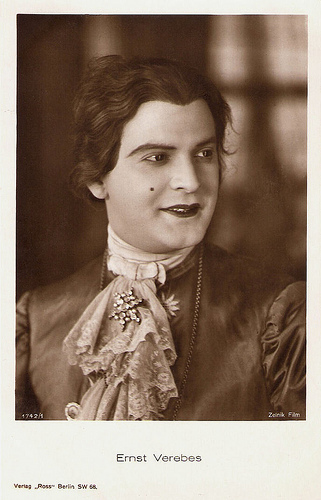
German postcard by Ross Verlag, no. 1742/1, 1927-1928. Photo: Zelnik Film.
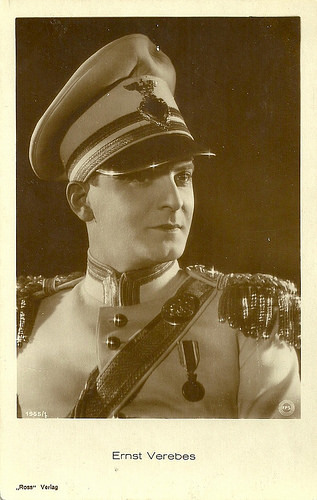
German postcard by Ross Verlag, no. 1955/1, 1927-1928. Photo: FPS.
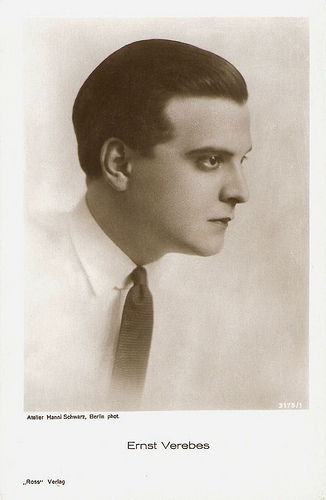
German postcard by Ross Verlag, no. 3175/1, 1928-1929. Photo: Atelier Hanni Schwarz, Berlin.
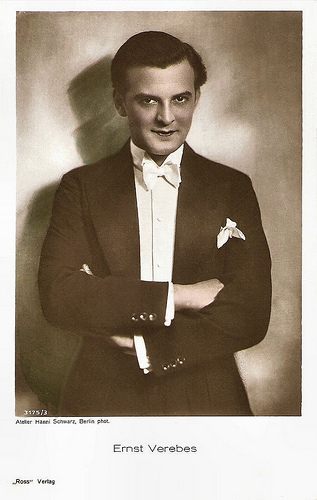
German postcard by Ross Verlag, no. 3175/3, 1928-1929. Photo: Hanni Schwarz, Berlin.
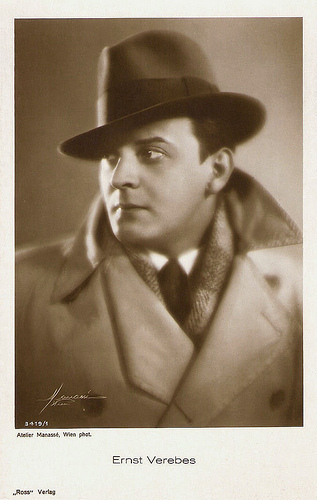
German postcard by Ross Verlag, no. 3419/1, 1928-1929. Photo: Atelier Atelier Manassé, Wien.
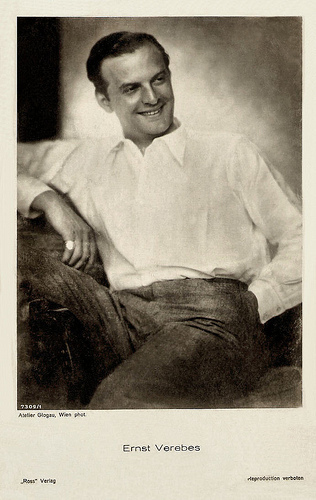
German postcard by Ross Verlag, no. 7309/1, 1932-1933. Photo: Atelier Glogau, Wien (Vienna).
Sources: (IMDb), Thomas Staedeli (Cyranos), Wikipedia, and .

German postcard by Ross Verlag, no. 1483/1, 1926-1927. Photo: Hanni Schwarz, Berlin.

German postcard by Ross Verlag, no. 1782/2, 1926-1927. Photo: Alex Binder.

German postcard by Ross Verlag, no. 3507/1, 1928-1929. Photo: Atelier Hanni Schwarz, Berlin.

German postcard by Ross Verlag, no. 3568/1, 1928-1929. Photo: Felsom-Film. Publicity still for Der fesche Husar (Geza von Bolvary, 1929).

German postcard by Ross Verlag, no. 5874/1, 1930-1931. Photo: Milan Kaufmann, Zagreb.

German postcard by Ross Verlag, no. 6146/1, 1931-1932. Photo: Aafa Film.
Hungary
Ernst Verebes was born as Ernö Verebes in New York in 1902. In 1914 his family returned to Hungary and there his film career began with Mire megvénülünk/The Seventh Veil (Ödön Uher ifj., 1917) and the Charles Dickens adaptation Twist Olivér/Oliver Twist (Márton Garas, 1919).
In the 1920s he appeared in such Hungarian films as A hetedik Fatyol (János Vanicsek, 1922), A Pál-utcai fiúk (Béla Balogh, 1924) based on a novel by Ferenc Molnár, and Holnap kezdödik az élet (Antal Forgács, 1924) with Maria Corda .
From 1925 on he became established as Ernst Verebes in the German film industry. He appeared in such films as Der Mann im Sattel/The Man in the Saddle (Manfred Noa, 1925), Gräfin Mariza/Countess Mariza (Hans Steinhoff, 1925), and Qualen der Nacht/Torments of the Night (Kurt Bernhardt/Curtis Bernhardt, 1926) with Claire Rommer .
Guy Bellinger at IMDb writes: "he was one of those manly actors, both well-built and charming, at ease as well in a military uniform as in a tuxedo and top hat, that German ladies loved to see on a big screen." Many more films followed, including Bigamie/Bigamy (Jaap Speyer, 1927) starring Heinrich George , Der Geisterzug/Ghost Train (Géza von Bolvary, 1927), Der Bettelstudent/The Beggar Student (Jacob Fleck, Luise Fleck, 1927) with Harry Liedtke .
Verebes appeared as a count opposite Lya Mara in Der Zigeunerbaron/The Gypsy Baron (Friedrich Zelnik aka Frederic Zelnik, 1927), and starred in Das Land ohne Frauen/Bride Number 68 (Carmine Gallone, 1929). Incidentally he also made Hungarian films like A Pál-utcai fúk/Paul Street Boys (Bela Balogh, 1929), based on a novel by Ferenc Molnar.

German postcard by Ross Verlag, no. 91/4. Photo: Aafa Film. Publicity still for Der Bettelstudent/The Beggar Student (Jacob Fleck, Luise Fleck, 1927) with Maria Paudler.

Dutch postcard by Filma, no. 369.

German postcard by Ross Verlag, no. 3693/1, 1928-1929. Photo: Atelier Badekow, Berlin.

Belgian postcard. by S.A. Cacao et Chocolat Kivou, Vilvo[o]rde, Belgium. For either a late silent or early sound film.

German postcard by Ross Verlag, no. 6647/1, 1931-1932. Photo: Atelier Binder, Berlin.

German postcard by Ross Verlag, no. 7394/1, 1932-1933. Photo: Aafa Film. Publicity still for Das blaue vom Himmel/The Blue from the Sky (Victor Janson, 1932) with Margarete Schlegel.
Germany and Hollywood
The German public acclaimed Ernst Verebes, especially in roles in uniform, such as the dashing hussar lieutenant in Der Tanzhusar/The Dancing Hussar (Fred Sauer, 1931) with Gretl Theimer . In the early 1930s he appeared in a whole string of German films including Va Banque (Erich Waschneck, 1930) starring Lil Dagover , Viktoria und ihr Husar/Victoria and Her Hussar (Richard Oswald, 1931), Die verliebte Firma/The Company's in Love (Max Ophüls, 1932), and Es wird schon wieder besser/Things Are Getting Better Already (Kurt Gerron, 1932) starring Dolly Haas and Heinz Rühmann .
Verebes was not desired by the Nazis and he moved to Austria where he appeared in Katharina die Letzte/Catherine the Last (Henry Koster, 1935) featuring Franciska Gaál . After the Anschluss of Austria to Nazi-Germany in 1936 Verebes decided to flee again and to take refuge in the US.
His career resumed there two years later but his matinee idol years were over. Verebes, now named Ernö again, first found a few acceptable supporting roles, mainly as the German or SS officer in office. He was seen in such films as A Desperate Adventure (John H. Auer, 1938) starring Ramon Novarro , Balalaika (Reinhold Schünzel, 1939), and The Hitler Gang (John Farrow, 1944). He is particularly memorable in a non military part, as the stage manager in Ernst Lubitsch 's classic To Be or Not To Be (Ernst Lubitsch, 1942).
After World War Two, he was only given bit parts to play. Guy Bellinger at IMDb : "a far cry from the star status he benefited from only one or two decades earlier. The strange thing is that, whatever the type a film he was in, he was most of the time cast as a ... waiter! For years on, in at least fifteen movies, he would serve drinks to actors and actresses lucky enough to have something interesting to play. Sure there were variants, Ernö Verebes could be a bartender, a head waiter, a wine steward or the captain of waiters but the former popular and elegant star understandably tired of unceasingly repeating the same ancillary gestures, he who had been a count, a hussar and a Don Juan."
Verebes decided to retire in 1953, only 51. His last bit part was in Houdini (George Marshall, 1953) starring Tony Curtis. Ernö Verebes died forgotten in 1971 in Los Angeles, at the age of 68.

German postcard by Ross Verlag, no. 1742/1, 1927-1928. Photo: Zelnik Film.

German postcard by Ross Verlag, no. 1955/1, 1927-1928. Photo: FPS.

German postcard by Ross Verlag, no. 3175/1, 1928-1929. Photo: Atelier Hanni Schwarz, Berlin.

German postcard by Ross Verlag, no. 3175/3, 1928-1929. Photo: Hanni Schwarz, Berlin.

German postcard by Ross Verlag, no. 3419/1, 1928-1929. Photo: Atelier Atelier Manassé, Wien.

German postcard by Ross Verlag, no. 7309/1, 1932-1933. Photo: Atelier Glogau, Wien (Vienna).
Sources: (IMDb), Thomas Staedeli (Cyranos), Wikipedia, and .
Published on August 08, 2016 22:00
August 7, 2016
Marina Berti
Italian actress Marina Berti (1924-2002) is a forgotten diva from the postwar Italian cinema. She was a popular starlet of Italian and Hollywood films in the 1940s and early 1950s – sometimes credited as Maureen Melrose.
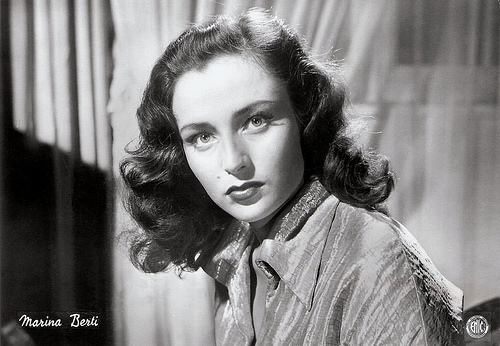
Italian postcard by Bromofoto, Milano (Milan), no. 981. Photo: ENIC.
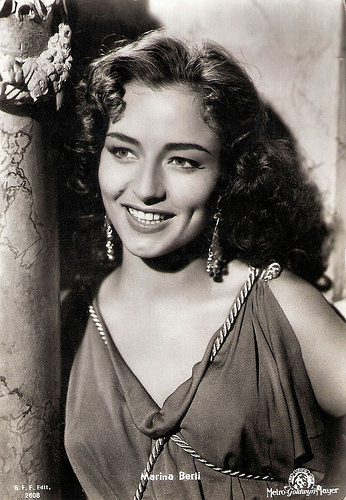
Italian postcard by B.F.F. Edit., no. 2608. Photo: Metro-Goldwyn-Mayer. Publicity still for Quo Vadis (Mervyn LeRoy, Anthony Mann, 1951).
English Skills
In 1924, Marina Berti was born as Elena Maureen Bertolini in London, Great Britain, to Italian parents. She returned to Italy with her family in 1936. Her first, uncredited screen appearance was in the Anna Magnani film La Fuggitiva/The Fugitive (Piero Ballerini, 1941).
In 1942 she was the female lead in Giacomo l'idealista/Giacomo the Idealist (Alberto Lattuada, 1943), an early melodrama in which she starred opposite Massimo Serato . She had another success opposite Amedeo Nazzari in La donna della montagna/The Mountain Woman (Renato Castellani, 1943), before the Italian film industry collapsed in the later stages of the war.
La storia di una capinera/The History of a Sparrow (Gennaro Righelli, 1943), for instance, was shot in 1943 but not released until 1945. It was on this film she met actor Emilio Giordana, aka Claudio Gora, who she married the following year. Subsequently they had three children who all went on to become actors, Andrea, Carlo and Marina Giordana.
Her romantic interest in La porta del cielo/The Gate of Heaven (Vittorio De Sica, 1945) was handsome Massimo Girotti , and the following year the beautiful couple starred together again in Preludio d'amore/Love Prelude (Giovanno Paolucci, 1946) with Vittorio Gassman . 45 years later, they would be reunited in Dall'altra parte del mondo/From the Other Side of the World (Arnaldo Catinari, 1992).
Born in London, Berti's English skills enabled her to appear also in Hollywood productions shot in Cinecittà such as the historical adventure Prince of Foxes (Henry King, 1949) opposite Tyrone Power , the crime drama Deported (Robert Siodmak, 1950) with Märta Torén , and the historical epic Quo Vadis (Mervyn LeRoy, 1951) with Deborah Kerr .
She did appear in one film shot in America, the comedy Up Front (Alexander Hall, 1951), based on the popular wartime cartoons Lowbrow G.I.s Willie and Joe. She didn’t endear herself to the Hollywood machine when she refused to appear in a skimpy bathing suit for PR photos, and her popularity never took off in the US.
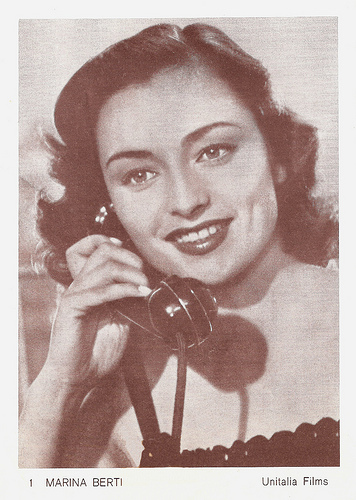
Belgian card by Cine Metro, no. 1. Photo: Unitalia Films.

Italian postcard by Bromofoto, Milano (Milan), no. 384. Photo: Atlantisfilm.
Amen
During her career of more than sixty years, Marina Berti appeared in nearly 100 films and TV series. During the 1950s, the nature of her roles began to change, from being a girlish love interest in films like Il testimone/The Testimony (Pietro Germi, 1946) to more of a character actress.
Most of her Italian films in this period were no big successes and in the popular Hollywood epics Ben Hur (William Wyler, 1959) and Cleopatra (Joseph L. Mankiewicz, 1963), which were partly shot in Italy, she just had uncredited parts (her part as the Queen of Tarsus in Cleopatra even ended on the cutting floor).
In the 1960s she played supporting parts in popular films like Madame Sans-Gêne (Christian-Jaque, 1962) starring Sophia Loren , and Made in Italy (Nanni Loy, 1965). Occasionally she was the leading leady, for instance in the war film Face in the Rain (Irvin Kershner, 1963) with Rory Calhoun.
She was very active in genre films such as the Peplum Il tiranno di Siracusa/The Tyrant of Syracuse (Curtis Bernhardt, 1962), the gothic horror Un angelo per Satana/An Angel for Satan (Camillo Mastrocinque, 1966) starring Barbara Steele, the Spaghetti Western Un uomo, un cavallo, una pistola/A Man, a Horse, a Gun (Luigi Vanzi, 1967), and the Giallos Qualcuno ha tradito/Every Man Is My Enemy (Franco Prosperi, 1967) with Robert Webber, and La polizia chiede aiuto/The Police Want Help (Massimo Dallamano, 1974) with Mario Adorf .
Her husband Claudio Gora directed her in three films, Il Cielo è rosso/The Sky Is Red (1950), Febbre di vivere/Eager to Live (1953), and the Spaghetti Western L’odio è il mio Dio/Hate Is My God (1969).
As the Italian film industry declined in the 1970s, she was more regularly found on television. She acted in such popular TV mini-series as L’Odissea/The Adventures of Ulysses (Franco Rossi, Mario Bava a.o., 1968), Moses the Lawgiver (Gianfranco De Bosio, 1974), Jesus of Nazareth (Franco Zeffirelli, 1977) and L’edera/The ivy (Fabrizio Costa, 1992).
Her later films include the drama La posta in gioco/The Stakes (Sergio Nasca, 1988) and Ostinato destino/Obstinate destiny (Gianfranco Albano, 1992) starring Monica Bellucci. Her last film appearance was a small part in the war drama Amen (Costa-Gavras, 2002).
Marina Berti died in 2002 in Rome, Italy, following an extended illness. She was 78. Her husband Claudio Gora had died in 1998.
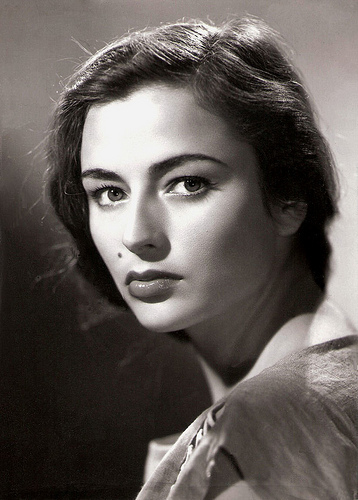
Italian photo card.
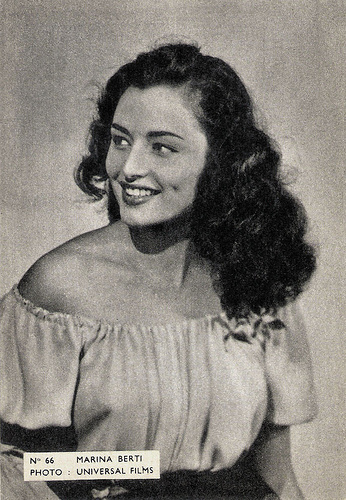
Belgian collectors card by Merbotex, Brussels for Ciné British Palace, Temse, no. 66. Photo: Universal Film. Publicity still for Up Front (Alexander Hall, 1951).
Source: Matt Blake (The Wild Eye), Jason Buchanan (AllMovie), Glamour Girls of the Silver Screen, Wikipedia and .

Italian postcard by Bromofoto, Milano (Milan), no. 981. Photo: ENIC.

Italian postcard by B.F.F. Edit., no. 2608. Photo: Metro-Goldwyn-Mayer. Publicity still for Quo Vadis (Mervyn LeRoy, Anthony Mann, 1951).
English Skills
In 1924, Marina Berti was born as Elena Maureen Bertolini in London, Great Britain, to Italian parents. She returned to Italy with her family in 1936. Her first, uncredited screen appearance was in the Anna Magnani film La Fuggitiva/The Fugitive (Piero Ballerini, 1941).
In 1942 she was the female lead in Giacomo l'idealista/Giacomo the Idealist (Alberto Lattuada, 1943), an early melodrama in which she starred opposite Massimo Serato . She had another success opposite Amedeo Nazzari in La donna della montagna/The Mountain Woman (Renato Castellani, 1943), before the Italian film industry collapsed in the later stages of the war.
La storia di una capinera/The History of a Sparrow (Gennaro Righelli, 1943), for instance, was shot in 1943 but not released until 1945. It was on this film she met actor Emilio Giordana, aka Claudio Gora, who she married the following year. Subsequently they had three children who all went on to become actors, Andrea, Carlo and Marina Giordana.
Her romantic interest in La porta del cielo/The Gate of Heaven (Vittorio De Sica, 1945) was handsome Massimo Girotti , and the following year the beautiful couple starred together again in Preludio d'amore/Love Prelude (Giovanno Paolucci, 1946) with Vittorio Gassman . 45 years later, they would be reunited in Dall'altra parte del mondo/From the Other Side of the World (Arnaldo Catinari, 1992).
Born in London, Berti's English skills enabled her to appear also in Hollywood productions shot in Cinecittà such as the historical adventure Prince of Foxes (Henry King, 1949) opposite Tyrone Power , the crime drama Deported (Robert Siodmak, 1950) with Märta Torén , and the historical epic Quo Vadis (Mervyn LeRoy, 1951) with Deborah Kerr .
She did appear in one film shot in America, the comedy Up Front (Alexander Hall, 1951), based on the popular wartime cartoons Lowbrow G.I.s Willie and Joe. She didn’t endear herself to the Hollywood machine when she refused to appear in a skimpy bathing suit for PR photos, and her popularity never took off in the US.

Belgian card by Cine Metro, no. 1. Photo: Unitalia Films.

Italian postcard by Bromofoto, Milano (Milan), no. 384. Photo: Atlantisfilm.
Amen
During her career of more than sixty years, Marina Berti appeared in nearly 100 films and TV series. During the 1950s, the nature of her roles began to change, from being a girlish love interest in films like Il testimone/The Testimony (Pietro Germi, 1946) to more of a character actress.
Most of her Italian films in this period were no big successes and in the popular Hollywood epics Ben Hur (William Wyler, 1959) and Cleopatra (Joseph L. Mankiewicz, 1963), which were partly shot in Italy, she just had uncredited parts (her part as the Queen of Tarsus in Cleopatra even ended on the cutting floor).
In the 1960s she played supporting parts in popular films like Madame Sans-Gêne (Christian-Jaque, 1962) starring Sophia Loren , and Made in Italy (Nanni Loy, 1965). Occasionally she was the leading leady, for instance in the war film Face in the Rain (Irvin Kershner, 1963) with Rory Calhoun.
She was very active in genre films such as the Peplum Il tiranno di Siracusa/The Tyrant of Syracuse (Curtis Bernhardt, 1962), the gothic horror Un angelo per Satana/An Angel for Satan (Camillo Mastrocinque, 1966) starring Barbara Steele, the Spaghetti Western Un uomo, un cavallo, una pistola/A Man, a Horse, a Gun (Luigi Vanzi, 1967), and the Giallos Qualcuno ha tradito/Every Man Is My Enemy (Franco Prosperi, 1967) with Robert Webber, and La polizia chiede aiuto/The Police Want Help (Massimo Dallamano, 1974) with Mario Adorf .
Her husband Claudio Gora directed her in three films, Il Cielo è rosso/The Sky Is Red (1950), Febbre di vivere/Eager to Live (1953), and the Spaghetti Western L’odio è il mio Dio/Hate Is My God (1969).
As the Italian film industry declined in the 1970s, she was more regularly found on television. She acted in such popular TV mini-series as L’Odissea/The Adventures of Ulysses (Franco Rossi, Mario Bava a.o., 1968), Moses the Lawgiver (Gianfranco De Bosio, 1974), Jesus of Nazareth (Franco Zeffirelli, 1977) and L’edera/The ivy (Fabrizio Costa, 1992).
Her later films include the drama La posta in gioco/The Stakes (Sergio Nasca, 1988) and Ostinato destino/Obstinate destiny (Gianfranco Albano, 1992) starring Monica Bellucci. Her last film appearance was a small part in the war drama Amen (Costa-Gavras, 2002).
Marina Berti died in 2002 in Rome, Italy, following an extended illness. She was 78. Her husband Claudio Gora had died in 1998.

Italian photo card.

Belgian collectors card by Merbotex, Brussels for Ciné British Palace, Temse, no. 66. Photo: Universal Film. Publicity still for Up Front (Alexander Hall, 1951).
Source: Matt Blake (The Wild Eye), Jason Buchanan (AllMovie), Glamour Girls of the Silver Screen, Wikipedia and .
Published on August 07, 2016 22:00
August 6, 2016
Charles Dullin
Charles Dullin (1885-1949) was a French actor, theatre manager and director. He was an important figure of the French non-commercial theatre of the first half of the 20th century. He also appeared in many classics of the French silent cinema.
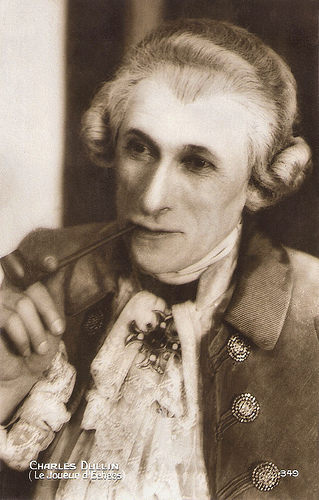
French postcard by Editions Cinémagazine, Paris, no. 349. Photo: publicity still for Le joueur d'échecs/The Chess Player (Raymond Bernard, 1927).
The Stage As Vocation
Charles Dullin was born in Yenne, Savoie in 1885. He was the youngest of a family of 19 children, a family devoted to traditional values.
Destined for a clerical career, Dullin knew his vocation was with the stage and at age 18, he traveled from Lyon to Paris, where he lived in the artist’s housing complex Le Bateau-Lavoir, together with artists such as Max Jacob, Mac Orlan, Harry Baur , Henri Matisse and Georges Braque. Like other artists, poverty, hunger, disease and money problems were normal to him.
After working at the Théâtre des Gobelins and the Lapin agile he shifted to the Théâtre de l'Odéon in 1906. His first role there was in William Shakespeare’s Julius Caesar, directed by André Antoine.
In 1908 he created his own company, then moved in 1910 to the Théâtre des Arts, directed by Jacques Rouché, where his role of Smerdjakov in The Brothers Karamazov (dir. Jacques Copeau) furthered him fame.
When in 1913, Copeau opened the Vieux-Colombier theatre in the former Athenaeum-Saint-Germain, Dullin became his right hand, with Louis Jouvet as one of the principal actors. After the First World War he traveled with Copeau to New York, then worked with Firmin Gémier .
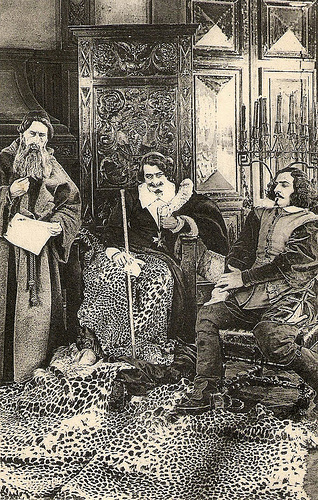
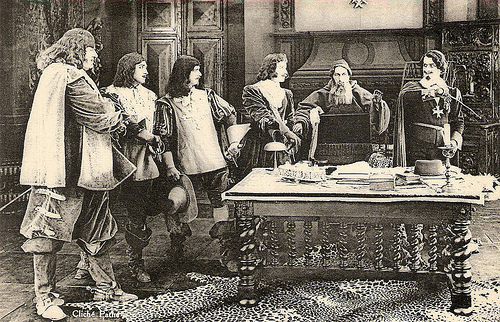
Two French postcards by M. Le Deley, Paris. Photos: stills from Les Trois Mousquetaires/The Three Musketeers (1921), based on the famous novel by Alexandre Dumas père, and produced by Pathé Consortium Cinéma.
Full Houses
In 1921 Charles Dullin opened his Théâtre de l'Atelier in Paris, where he pursued the lessons of Copeau, i.e. respect for the text, and the creation of stage actors. He staged modern playwrights like Luigi Pirandello and Marcel Achard, but also classic authors like William Shakespeare and Aristophanes.
While some shows were given to almost empty auditoria, plays like L’Avare by Molière (1922) and Volpone by Ben Johnson (1928; adapted by Jules Romains and Stefan Zweig) drew full houses. In 1927 Dullin joined the Cartel des Quatre, together with three other theatre managers: Louis Jouvet , Georges Pitoëff and Gaston Baty, who wanted to save the non-commercial theatre.
Between 1940 and 1947 Dullin was managing director of the Theatre de la Cité, the former Theatre Sarah Bernhardt, rebaptised during the war because of Bernhardt’s Jewish’ descent. It was here that Dullin staged Jean-Paul Sartre’s Les Mouches/The Flies in 1943, despite German censorship.
Because of his work during the war, Dullin was criticized afterwards. In 1947 he left the – debt-ridden - Theatre de la Cité and joined the Theatre de Montparnasse of his ex-pupil from l’ Atelier, Marguerite Jamois.
From the late 1930s on, Dullin was active in the movement of the 'decentralised popular theatre'. Among Dullin’s pupils were Antonin Artaud, Madeleine Robinson , Jean-Louis Barrault , Jean Marais , Roger Blin, Alain Cuny , Roland Petit, and Marcel Marceau.
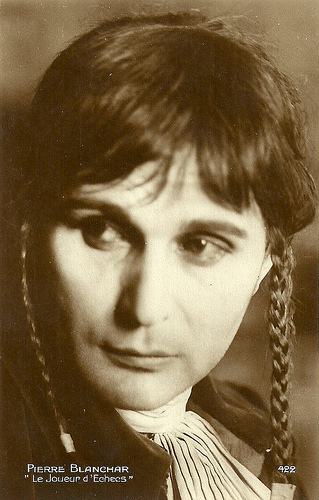
Pierre Blanchar. French postcard. Photo: publicity still for Le joueur d’échecs/The Chess Player (Raymond Bernard, 1927).
A Skilful, Intelligent and Malicious French King
All this theatre activity did not stop Charles Dullin acting in various films in the 1910s to the 1940s. After a bit part in the short Orgie romaine/Roman Orgy (Louis Feuillade, 1911), Dullin played in Âmes d’orient/Souls of The Orient (Léon Poirier, 1919-1922), Le secret de Rosette Lambert/The Secret of Rosette Lambert (Raymond Bernard, 1920), and the comedy L’Homme qui vendît son âme au diable/The Man Who Sold His Soul To The Devil (Pierre Caron, 1920).
In 1921 he appeared as Father Joseph in the 12 episodes serial Les Trois Mousquetaires/The Three Musketeers (Henri Diamant-Berger, 1921), starring Aimé Simon-Girard .
But he had his breakthrough in the silent cinema with the lead of Louis XI in the epic film Le miracle des loups/Miracle of the Wolves (Raymond Bernard, 1924), which contained spectacular battle scenes shot at Carcassonne. Dullin plays a skilful, intelligent and malicious French king who one by one manages to unite the different parts of France still occupied by the Burgundians and others.
His next role was that of Baron van Kempelen in Le joueur d’échecs/The Chess Player (Raymond Bernard, 1927), starring Pierre Blanchar and Edith Jéhanne . Dullin plays an 18th century Austrian diplomat who supposedly has invented an automaton that plays chess. Inside a Polish resistance fighter (Blanchar) is hidden. The story was based on a real Baron van Kempelen and his chess-playing automaton with the shape of a Turk.
Dullin then played the title role in Maldone/Misdeal (Jean Grémillon, 1928) opposite his wife, Marcelle Charles Dullin. The former runaway Maldone, now a well to do, cannot forget the attractive gypsy he met while wandering. When they meet again, he hits the road once more.
Dullin’s last silent role was in the German-French horror film Cagliostro (Richard Oswald, 1929), in which Hans Stüwe played Cagliostro.
In the sound era Dullin performed in Les Misérables (Raymond Bernard, 1934) starring Harry Baur ; in L’affaire du courrier de Lyon/Courier of Lyons (Claude Autant-Lara, Maurice Lehmann, 1937), starring Pierre Blanchar ; Mademoiselle docteur/Spies from Salonika (G.W. Pabst, 1937) starring Dita Parlo ; and Volpone (Maurice Tourneur, 1941) starring, again, Harry Baur .
After the war, Dullin played in two more interesting films: the fantasy Les jeux sont faits/Second Chance (Jean Delannoy, 1947), written by Jean-Paul Sartre and starring Micheline Presle , and the excellent crime drama Quai des Orfèvres/Quay of the Goldsmiths (Henri-Georges Clouzot, 1947), starring Louis Jouvet .
Charles Dullin died in Paris in 1949. He was 64.
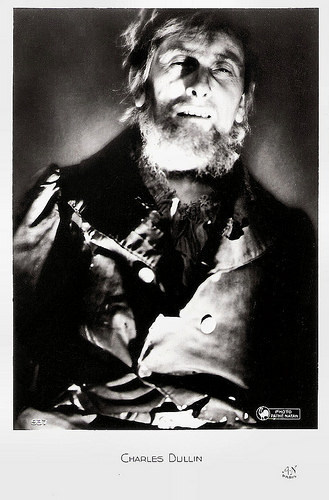
French postcard by A.N., Paris, no. 937. Photo: Pathé Natan. Charles Dullin as the evil Thénardier in the film Les Misérables (Raymond Bernard, 1934), starring Harry Baur as Jean Valjean, and adapated from the often filmed novel by Victor Hugo.
Sources: Wikipedia (French, English and Dutch) and .

French postcard by Editions Cinémagazine, Paris, no. 349. Photo: publicity still for Le joueur d'échecs/The Chess Player (Raymond Bernard, 1927).
The Stage As Vocation
Charles Dullin was born in Yenne, Savoie in 1885. He was the youngest of a family of 19 children, a family devoted to traditional values.
Destined for a clerical career, Dullin knew his vocation was with the stage and at age 18, he traveled from Lyon to Paris, where he lived in the artist’s housing complex Le Bateau-Lavoir, together with artists such as Max Jacob, Mac Orlan, Harry Baur , Henri Matisse and Georges Braque. Like other artists, poverty, hunger, disease and money problems were normal to him.
After working at the Théâtre des Gobelins and the Lapin agile he shifted to the Théâtre de l'Odéon in 1906. His first role there was in William Shakespeare’s Julius Caesar, directed by André Antoine.
In 1908 he created his own company, then moved in 1910 to the Théâtre des Arts, directed by Jacques Rouché, where his role of Smerdjakov in The Brothers Karamazov (dir. Jacques Copeau) furthered him fame.
When in 1913, Copeau opened the Vieux-Colombier theatre in the former Athenaeum-Saint-Germain, Dullin became his right hand, with Louis Jouvet as one of the principal actors. After the First World War he traveled with Copeau to New York, then worked with Firmin Gémier .


Two French postcards by M. Le Deley, Paris. Photos: stills from Les Trois Mousquetaires/The Three Musketeers (1921), based on the famous novel by Alexandre Dumas père, and produced by Pathé Consortium Cinéma.
Full Houses
In 1921 Charles Dullin opened his Théâtre de l'Atelier in Paris, where he pursued the lessons of Copeau, i.e. respect for the text, and the creation of stage actors. He staged modern playwrights like Luigi Pirandello and Marcel Achard, but also classic authors like William Shakespeare and Aristophanes.
While some shows were given to almost empty auditoria, plays like L’Avare by Molière (1922) and Volpone by Ben Johnson (1928; adapted by Jules Romains and Stefan Zweig) drew full houses. In 1927 Dullin joined the Cartel des Quatre, together with three other theatre managers: Louis Jouvet , Georges Pitoëff and Gaston Baty, who wanted to save the non-commercial theatre.
Between 1940 and 1947 Dullin was managing director of the Theatre de la Cité, the former Theatre Sarah Bernhardt, rebaptised during the war because of Bernhardt’s Jewish’ descent. It was here that Dullin staged Jean-Paul Sartre’s Les Mouches/The Flies in 1943, despite German censorship.
Because of his work during the war, Dullin was criticized afterwards. In 1947 he left the – debt-ridden - Theatre de la Cité and joined the Theatre de Montparnasse of his ex-pupil from l’ Atelier, Marguerite Jamois.
From the late 1930s on, Dullin was active in the movement of the 'decentralised popular theatre'. Among Dullin’s pupils were Antonin Artaud, Madeleine Robinson , Jean-Louis Barrault , Jean Marais , Roger Blin, Alain Cuny , Roland Petit, and Marcel Marceau.

Pierre Blanchar. French postcard. Photo: publicity still for Le joueur d’échecs/The Chess Player (Raymond Bernard, 1927).
A Skilful, Intelligent and Malicious French King
All this theatre activity did not stop Charles Dullin acting in various films in the 1910s to the 1940s. After a bit part in the short Orgie romaine/Roman Orgy (Louis Feuillade, 1911), Dullin played in Âmes d’orient/Souls of The Orient (Léon Poirier, 1919-1922), Le secret de Rosette Lambert/The Secret of Rosette Lambert (Raymond Bernard, 1920), and the comedy L’Homme qui vendît son âme au diable/The Man Who Sold His Soul To The Devil (Pierre Caron, 1920).
In 1921 he appeared as Father Joseph in the 12 episodes serial Les Trois Mousquetaires/The Three Musketeers (Henri Diamant-Berger, 1921), starring Aimé Simon-Girard .
But he had his breakthrough in the silent cinema with the lead of Louis XI in the epic film Le miracle des loups/Miracle of the Wolves (Raymond Bernard, 1924), which contained spectacular battle scenes shot at Carcassonne. Dullin plays a skilful, intelligent and malicious French king who one by one manages to unite the different parts of France still occupied by the Burgundians and others.
His next role was that of Baron van Kempelen in Le joueur d’échecs/The Chess Player (Raymond Bernard, 1927), starring Pierre Blanchar and Edith Jéhanne . Dullin plays an 18th century Austrian diplomat who supposedly has invented an automaton that plays chess. Inside a Polish resistance fighter (Blanchar) is hidden. The story was based on a real Baron van Kempelen and his chess-playing automaton with the shape of a Turk.
Dullin then played the title role in Maldone/Misdeal (Jean Grémillon, 1928) opposite his wife, Marcelle Charles Dullin. The former runaway Maldone, now a well to do, cannot forget the attractive gypsy he met while wandering. When they meet again, he hits the road once more.
Dullin’s last silent role was in the German-French horror film Cagliostro (Richard Oswald, 1929), in which Hans Stüwe played Cagliostro.
In the sound era Dullin performed in Les Misérables (Raymond Bernard, 1934) starring Harry Baur ; in L’affaire du courrier de Lyon/Courier of Lyons (Claude Autant-Lara, Maurice Lehmann, 1937), starring Pierre Blanchar ; Mademoiselle docteur/Spies from Salonika (G.W. Pabst, 1937) starring Dita Parlo ; and Volpone (Maurice Tourneur, 1941) starring, again, Harry Baur .
After the war, Dullin played in two more interesting films: the fantasy Les jeux sont faits/Second Chance (Jean Delannoy, 1947), written by Jean-Paul Sartre and starring Micheline Presle , and the excellent crime drama Quai des Orfèvres/Quay of the Goldsmiths (Henri-Georges Clouzot, 1947), starring Louis Jouvet .
Charles Dullin died in Paris in 1949. He was 64.

French postcard by A.N., Paris, no. 937. Photo: Pathé Natan. Charles Dullin as the evil Thénardier in the film Les Misérables (Raymond Bernard, 1934), starring Harry Baur as Jean Valjean, and adapated from the often filmed novel by Victor Hugo.
Sources: Wikipedia (French, English and Dutch) and .
Published on August 06, 2016 22:00
August 5, 2016
Annet Nieuwenhuyzen (1930-2016)
Yesterday, 5 August 2016, Dutch stage, TV and film actress Annet Nieuwenhuyzen (1930-2016) has died. She was one of the Grand Dames of the Dutch theatre. Nieuwenhuyzen won many awards, including a Golden Calf for her part in the film Leedvermaak (1989). She was 85.
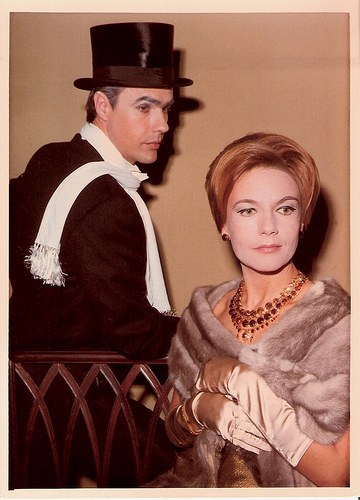
Dutch card to promote the stage musical Ja, ik wil/I do! I do!, a coproduction by Nieuw Rotterdams Toneel and Paul Kijzer. Annet Nieuwenhuyzen and Eric Schneider were the leads.
One of the icons of the Dutch stage
Annet Nieuwenhuyzen (sometimes written as Nieuwenhuijzen) was born in 1930 in Utrecht, The Netherlands. In 1953, she made her stage debut at De Haagse Comedie in The Hague after being spotted in a student production of the play Summer and Smoke by Tennessee Williams. She was studying political and social sciences in Amsterdam at the time.
Although she never trained as an actress, Nieuwenhuyzen became one of the icons of the Dutch stage during her long career. She played important parts for the Dutch theatre companies De Haagse Comedie, Het Rotterdams Toneel, Globe, Publiekstheater and Toneelgroep Amsterdam. She starred in the Greek classics and the plays by Anton Chekhov, Henrik Ibsen en Berthold Brecht.
Twice, she won the Dutch version of the Tony Award, the Theo d'Or for Best Actress, for her performances in the plays Barefoot in the Park (1965) / Mourning becomes Electra (1965) and for The Good Person of Szechwan (1975). She also appeared in lighter genres. She proved to be a gifted singer in musicals like Ja, ik wil/I do! I do! and A Little Night Music.
She was also a beloved television actress and appeared in such acclaimed TV drama series as Bij nader inzien/On closer inspection (Frans Weisz, 1991), Oud Geld/Old Money (Rudolf van den Berg, 1998-1999), Wet & Waan/Law & Delusion (Ben Sombogaart a.o., 2000), and Keyzer & De Boer Advocaten/Keyzer & De Boer Lawyers (Pim van Hoeve a.o., 2006-2007).
Annet Nieuwenhuyzen was the wearer of the Theo Mann-Bouwmeesterring; the highest award for a Dutch actress. In 1994 she forwarded the ring to actress Anne-Wil Blankers.
Dutch trailer for Zus & zo/Hotel Paraiso (2001). Source: Nederlands Film Festival (YouTube).
Polonaise
Annet Nieuwenhuyzen also appeared in several films. Her cinema debut was the comedy Kleren maken de man/Clothes make the man (Georg Jacoby, 1957), starring Kees Brusse. Later, Nieuwenhuyzen appeared in such films as Een pak slaag/Mr. Slotter's Jubilee (Bert Haanstra, 1979), again opposite Kees Brusse, and Afzien/Forgo (Gerrard Verhage, 1986), starring Gerardjan Rijnders.
For her role in the film Leedvermaak/Polonaise (Frans Weisz, 1989) about a Jewish family after WW II, she was awarded the Gouden Kalf, the Dutch Academy Award, for Best Actress. Chip Douglas at IMDb : “The film was critically lauded and received a number of prices, including 'Golden Calf' awards for (director Frans) Weisz, (actor Pierre) Bokma and Nieuwenhuijzen. This inspired the director, the playwright and the entire cast to reunite a dozen years later for Qui vive (following the same family in the Eighties) and another eight years after that with Happy End (the final part set in the Nineties).”
Other films in which Annet Nieuwenhuyzen appeared were Zus & zo/Hotel Paraiso (Paula van der Oest, 2001), and the mockumentary Master Class (Hans Teeuwen, 2007).
Annet Nieuwenhuyzen had a longtime relationship with former TV presenter Kick Stokhuyzen, and since 2012, she was married to theatre historian Xandra Knebel. Actor Victor Reinier is her nephew.
Trailer Happy End (2009). Source: Nederlands Film Festival (YouTube).
Sources: Chip Douglas (IMDb), De Volkskrant (Dutch), Theaterencyclopedie (Dutch), Dutch News, Wikipedia (Dutch) and .

Dutch card to promote the stage musical Ja, ik wil/I do! I do!, a coproduction by Nieuw Rotterdams Toneel and Paul Kijzer. Annet Nieuwenhuyzen and Eric Schneider were the leads.
One of the icons of the Dutch stage
Annet Nieuwenhuyzen (sometimes written as Nieuwenhuijzen) was born in 1930 in Utrecht, The Netherlands. In 1953, she made her stage debut at De Haagse Comedie in The Hague after being spotted in a student production of the play Summer and Smoke by Tennessee Williams. She was studying political and social sciences in Amsterdam at the time.
Although she never trained as an actress, Nieuwenhuyzen became one of the icons of the Dutch stage during her long career. She played important parts for the Dutch theatre companies De Haagse Comedie, Het Rotterdams Toneel, Globe, Publiekstheater and Toneelgroep Amsterdam. She starred in the Greek classics and the plays by Anton Chekhov, Henrik Ibsen en Berthold Brecht.
Twice, she won the Dutch version of the Tony Award, the Theo d'Or for Best Actress, for her performances in the plays Barefoot in the Park (1965) / Mourning becomes Electra (1965) and for The Good Person of Szechwan (1975). She also appeared in lighter genres. She proved to be a gifted singer in musicals like Ja, ik wil/I do! I do! and A Little Night Music.
She was also a beloved television actress and appeared in such acclaimed TV drama series as Bij nader inzien/On closer inspection (Frans Weisz, 1991), Oud Geld/Old Money (Rudolf van den Berg, 1998-1999), Wet & Waan/Law & Delusion (Ben Sombogaart a.o., 2000), and Keyzer & De Boer Advocaten/Keyzer & De Boer Lawyers (Pim van Hoeve a.o., 2006-2007).
Annet Nieuwenhuyzen was the wearer of the Theo Mann-Bouwmeesterring; the highest award for a Dutch actress. In 1994 she forwarded the ring to actress Anne-Wil Blankers.
Dutch trailer for Zus & zo/Hotel Paraiso (2001). Source: Nederlands Film Festival (YouTube).
Polonaise
Annet Nieuwenhuyzen also appeared in several films. Her cinema debut was the comedy Kleren maken de man/Clothes make the man (Georg Jacoby, 1957), starring Kees Brusse. Later, Nieuwenhuyzen appeared in such films as Een pak slaag/Mr. Slotter's Jubilee (Bert Haanstra, 1979), again opposite Kees Brusse, and Afzien/Forgo (Gerrard Verhage, 1986), starring Gerardjan Rijnders.
For her role in the film Leedvermaak/Polonaise (Frans Weisz, 1989) about a Jewish family after WW II, she was awarded the Gouden Kalf, the Dutch Academy Award, for Best Actress. Chip Douglas at IMDb : “The film was critically lauded and received a number of prices, including 'Golden Calf' awards for (director Frans) Weisz, (actor Pierre) Bokma and Nieuwenhuijzen. This inspired the director, the playwright and the entire cast to reunite a dozen years later for Qui vive (following the same family in the Eighties) and another eight years after that with Happy End (the final part set in the Nineties).”
Other films in which Annet Nieuwenhuyzen appeared were Zus & zo/Hotel Paraiso (Paula van der Oest, 2001), and the mockumentary Master Class (Hans Teeuwen, 2007).
Annet Nieuwenhuyzen had a longtime relationship with former TV presenter Kick Stokhuyzen, and since 2012, she was married to theatre historian Xandra Knebel. Actor Victor Reinier is her nephew.
Trailer Happy End (2009). Source: Nederlands Film Festival (YouTube).
Sources: Chip Douglas (IMDb), De Volkskrant (Dutch), Theaterencyclopedie (Dutch), Dutch News, Wikipedia (Dutch) and .
Published on August 05, 2016 22:00
August 4, 2016
EFSP's Dazzling Dozen: News from Didier
We were happy to receive new scans from Didier Hanson in Spain. He acquired interesting rare vintage postcards dating from the era of the Russian Empire. Included were postcards of legendary stage productions of the Moscow Art Theatre, directed by Konstantin Stanislavsky. There was also a series of postcards of Feodor Chaliapin, probably the best opera singer ever. Didier also sent us postcards of the silent film divas Vera Kholodnaya, Vera Karalli and Pola Negri. My favourite is the one with a scene from Ernst Lubitsch's Die Augen der Mumie Ma/The Eyes of the Mummy (1918). Watch the mirror!
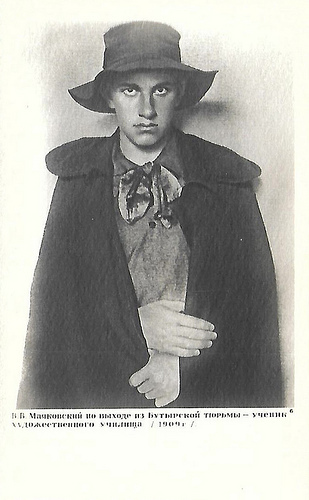
Vladimir Mayakovsky, 1909. Russian postcard. Collection: Didier Hanson.
Russian poet and actor Vladimir Mayakovsky (1893-1930) was a prominent figure of the Russian Futurist movement. He produced a large and diverse body of work: he wrote poems, wrote and directed plays, appeared in films, edited the art journal LEF, and created agitprop posters in support of the Communist Party during the Russian Civil War. Though Mayakovsky's work regularly demonstrated ideological and patriotic support for the ideology of the Communist Party, his relationship with the Soviet state was always complex and often tumultuous.
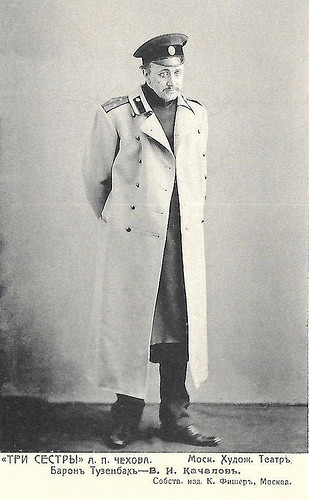
Russian postcard. Photo: Moscow Art Theatre. Publicity still for the stage play Tri sestry/Three Sisters by Anton Chekhov. It was written in 1900 and first performed in 1901 at the Moscow Art Theatre. Vasily Kachalov played the part of Baron Nikolaj Lvovich Tuzenbach. Collection: Didier Hanson.
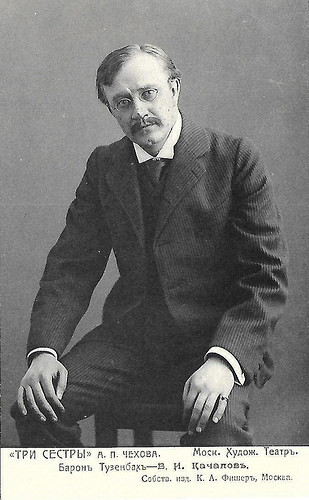
Russian postcard. Photo: K. Fisher / Moscow Art Theatre. Publicity still for the stage play Tri sestry/Three Sisters by Anton Chekhov. It was written in 1900 and first performed in 1901 at the Moscow Art Theatre. Vasily Kachalov played the part of Baron Nikolaj Lvovich Tuzenbach. Collection: Didier Hanson.
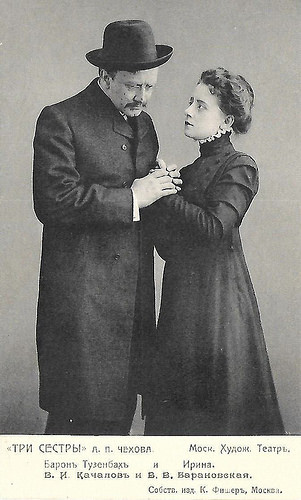
Russian postcard. Photo: K. Fisher / Moscow Art Theatre. Publicity still for the stage play Tri sestry/Three Sisters by Anton Chekhov. It was written in 1900 and first performed in 1901 at the Moscow Art Theatre. Vasily Kachalov played the part of Baron Nikolaj Lvovich Tuzenbach and Vera Baranovskaya played Irina, the youngest sister. Collection: Didier Hanson.
Russian film and stage actor Vasily Kachalov (1875-1948) was one of Konstantin Stanislavsky's best known performers. He led the so-called Kachalov Group within the Moscow Art Theatre. He also appeared in four films.
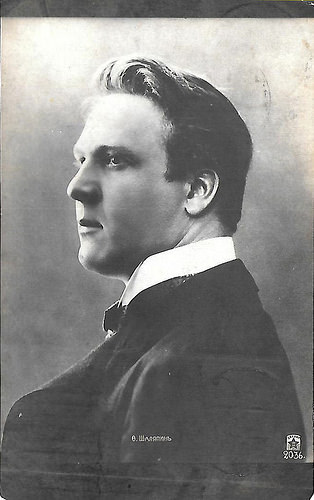
Feodor Chaliapin. Russian postcard, no. 2036. Collection: Didier Hanson.
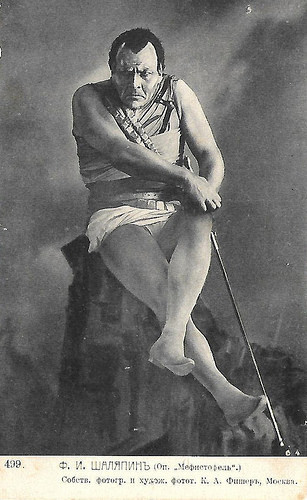
Feodor Chaliapin as Mephisto. Russian postcard, no. 499. Photo: K. Fisher. Publicity still for the stage production of Arrigo Boito's opera Mefistofele. Collection: Didier Hanson.
Feodor Ivanovich Chaliapin (Russian: Фёдор Ива́нович Шаля́пин) (1873–1938) was a Russian opera singer. The possessor of a large, deep and expressive bass voice, he enjoyed an important international career at major opera houses and is often credited with establishing the tradition of naturalistic acting in his chosen art form.
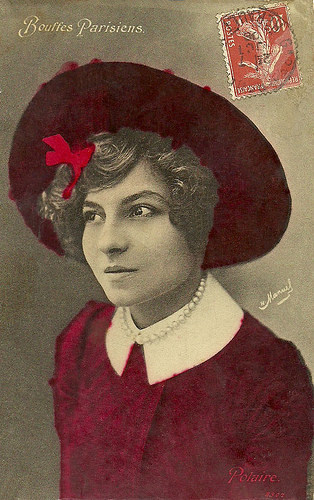
Polaire. French postcard, no. 8307. Photo: H. Manuel. Publicity still for the stage play Claudine à Paris (1902) at the Théâtre des Bouffes Parisiens. Collection: Didier Hanson.
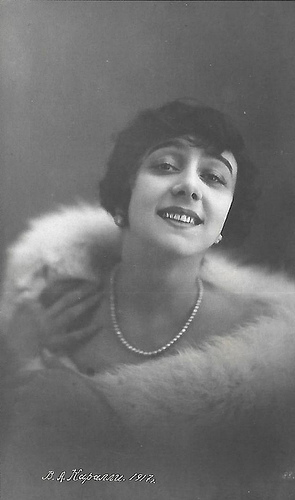
Vera Karalli, 1917. Russian postcard. Collection: Didier Hanson.
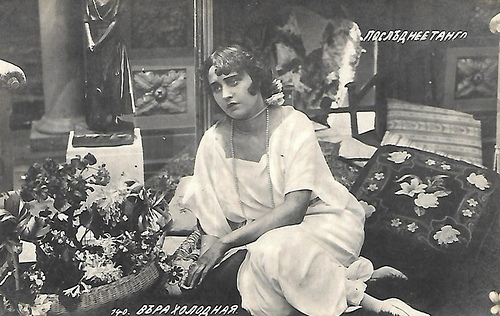
Russian postcard, no. 140. Photo: publicity still for Posledneiye tango/Last Tango (Vyacheslav Viskovsky, 1918) with Vera Kholodnaya . Collection: Didier Hanson.
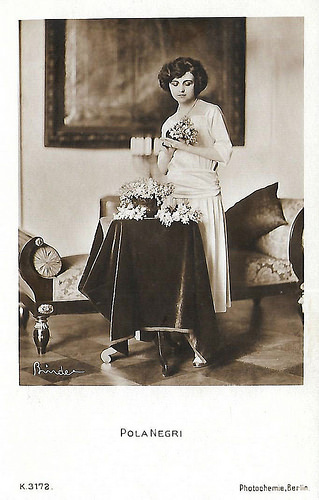
Pola Negri . German postcard by Photochemie, Berlin, no. K. 3172. Photo: Alex Binder. Collection: Didier Hanson.
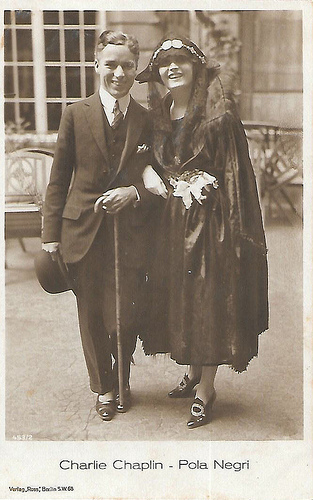
Charlie Chaplin and Pola Negri . Germna postcard by Ross Verlag, no. 453/2, 1919-1924. Collection: Didier Hanson.
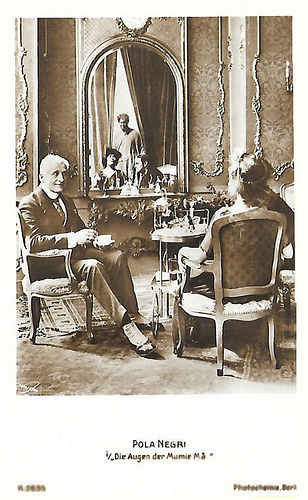
German postcard by Photochemie, Berlin, no. K. 2835. Photo: publicity still for Die Augen der Mumie Ma/The Eyes of the Mummy (Ernst Lubitsch, 1918) with Pola Negri . Collection: Didier Hanson.
Thanks, Didier!
This is a post for Postcard Friendship Friday, hosted by Beth at the The Best Hearts are Crunchy. You can visit her by clicking on the button below.


Vladimir Mayakovsky, 1909. Russian postcard. Collection: Didier Hanson.
Russian poet and actor Vladimir Mayakovsky (1893-1930) was a prominent figure of the Russian Futurist movement. He produced a large and diverse body of work: he wrote poems, wrote and directed plays, appeared in films, edited the art journal LEF, and created agitprop posters in support of the Communist Party during the Russian Civil War. Though Mayakovsky's work regularly demonstrated ideological and patriotic support for the ideology of the Communist Party, his relationship with the Soviet state was always complex and often tumultuous.

Russian postcard. Photo: Moscow Art Theatre. Publicity still for the stage play Tri sestry/Three Sisters by Anton Chekhov. It was written in 1900 and first performed in 1901 at the Moscow Art Theatre. Vasily Kachalov played the part of Baron Nikolaj Lvovich Tuzenbach. Collection: Didier Hanson.

Russian postcard. Photo: K. Fisher / Moscow Art Theatre. Publicity still for the stage play Tri sestry/Three Sisters by Anton Chekhov. It was written in 1900 and first performed in 1901 at the Moscow Art Theatre. Vasily Kachalov played the part of Baron Nikolaj Lvovich Tuzenbach. Collection: Didier Hanson.

Russian postcard. Photo: K. Fisher / Moscow Art Theatre. Publicity still for the stage play Tri sestry/Three Sisters by Anton Chekhov. It was written in 1900 and first performed in 1901 at the Moscow Art Theatre. Vasily Kachalov played the part of Baron Nikolaj Lvovich Tuzenbach and Vera Baranovskaya played Irina, the youngest sister. Collection: Didier Hanson.
Russian film and stage actor Vasily Kachalov (1875-1948) was one of Konstantin Stanislavsky's best known performers. He led the so-called Kachalov Group within the Moscow Art Theatre. He also appeared in four films.

Feodor Chaliapin. Russian postcard, no. 2036. Collection: Didier Hanson.

Feodor Chaliapin as Mephisto. Russian postcard, no. 499. Photo: K. Fisher. Publicity still for the stage production of Arrigo Boito's opera Mefistofele. Collection: Didier Hanson.
Feodor Ivanovich Chaliapin (Russian: Фёдор Ива́нович Шаля́пин) (1873–1938) was a Russian opera singer. The possessor of a large, deep and expressive bass voice, he enjoyed an important international career at major opera houses and is often credited with establishing the tradition of naturalistic acting in his chosen art form.

Polaire. French postcard, no. 8307. Photo: H. Manuel. Publicity still for the stage play Claudine à Paris (1902) at the Théâtre des Bouffes Parisiens. Collection: Didier Hanson.

Vera Karalli, 1917. Russian postcard. Collection: Didier Hanson.

Russian postcard, no. 140. Photo: publicity still for Posledneiye tango/Last Tango (Vyacheslav Viskovsky, 1918) with Vera Kholodnaya . Collection: Didier Hanson.

Pola Negri . German postcard by Photochemie, Berlin, no. K. 3172. Photo: Alex Binder. Collection: Didier Hanson.

Charlie Chaplin and Pola Negri . Germna postcard by Ross Verlag, no. 453/2, 1919-1924. Collection: Didier Hanson.

German postcard by Photochemie, Berlin, no. K. 2835. Photo: publicity still for Die Augen der Mumie Ma/The Eyes of the Mummy (Ernst Lubitsch, 1918) with Pola Negri . Collection: Didier Hanson.
Thanks, Didier!
This is a post for Postcard Friendship Friday, hosted by Beth at the The Best Hearts are Crunchy. You can visit her by clicking on the button below.

Published on August 04, 2016 22:00
August 3, 2016
Carlo Ninchi
Carlo Ninchi (1896-1974) was an Italian stage and screen actor, who appeared in almost 130 Italian films between the 1930s and 1960s. He was the younger brother of Annibale Ninchi and a cousin of Ave Ninchi.
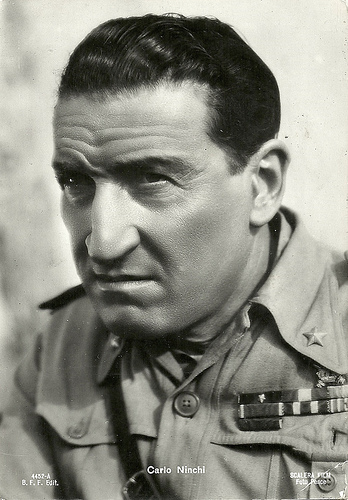
Italian postcard by B.F.F. Edit (Ballerini & Fratini Editori), Firenze, no. 4452-A. Photo: Pesce / Scalera Film. Carlo Ninchi in Giarabub (Goffredo Alessandrini, 1942).
Great productive resources and a supercast
Carlo Ninchi was born in Bologna, Italy in 1896.
He debuted in the theatre company of his brother Annibale Ninchi , as Pilades in Alfieri’s Orestes. From then on, he was engaged by the major Italian stage companies, where he shared the stage with such other future great actors as Paolo Stoppa and Gino Cervi .
From the start of the Italian sound cinema in 1930 he acted in films. He alternated leads with supporting parts, starting with Corte d’Assise/Before the Jury (Guido Brignone 1930) with Marcella Albani . It was followed by Terra madre/Mother Earth (Alessandro Blasetti, 1931) with Leda Gloria .
He was Hagenbach opposite Germana Paolieri ’s Wally in La Wally (Guido Brignone, 1931), and Compare Alfio in Cavalleria rusticana (Amleto Palermi, 1939), both films based on famous operas. In the latter film he acted opposite Isa Pola and the sex symbol of the fascist regime, Doris Duranti .
Also in 1939 he acted in Mario Soldati’s romantic comedy Dora Nelson as a rich industrial whose runaway wife, a spoiled actress, is substituted on the set but also in private by a lookalike (a double role by Assia Noris ). The husband finally dumps his diva and marries the simple girl.
During the war years Ninchi, who had already acted in the fascist propaganda film Camicia nera/Black Shirt (Giovacchino Forzano, 1933), alternated propaganda films such as the colonial film Giarabub (Goffredo Alessandrini, 1942) and the anti-Soviet film Odessa in fiamme/Odessa in Flames (Carmine Gallone, 1942) with modern drama, romantic comedy and historical films, such as Catene invisibili/Invisible Chains (Mario Mattoli, 1942) and Stasera niente di nuovo/Nothing New Tonight (Mario Mattoli, 1942), both starring Alida Valli .
Ninchi acted opposite Maria Mercader in La porta del cielo/Heaven's Gate (Vittorio De Sica, 1945) and opposite Elio Parvo in Roberto Rossellini’s Desiderio (1943-46). Ninchi also played the tormented ‘Innominato’ in the Manzoni adaptation I promessi sposi/The Spirit and the Flesh (1941), directed by Mario Camerini and staged with great productive resources (the Milan Duomo as it looked like in 1627 was reconstructed on the studio lot) and a supercast.

Italian postcard by S.A. Grafitalia, Milano (Milan), no. 10. Photo: Film Lux. Publicity still for I Promessi Sposi/The Spirit and the Flesh (Mario Camerini, 1941) with Carlo Ninchi as L'Innominato.
Unforgettable comical personifications
In the later 1940s Carlo Ninchi was still highly active, for example in dramas with Clara Calamai such as L'adultera/The Adultress (Duilio Coletti, 1946) and Ultimo amore/Last Love (Mario Camerini, 1947). He also appeared opposite Rossano Brazzi and Valentina Cortese in Il passatore/The Ferryman (Duilio Coletti, 1947), which was co-written by Federico Fellini.
He also acted in comedies with Macario and Silvana Pampanini , such as Bellezze in bicicletta/Beauties on Bikes (Carlo Campogalliani, 1950), and in René Clair's fantasy film La beauté du diable/Beauty and the Devil (1950). In Camicie rosse/Red Shirts (Goffredo Alessandrini, Francesco Rosi, 1952), a biopic on Anita Garibaldi ( Anna Magnani ), Ninchi played the Italian revolutionary nationalist Ciceruacchio.
But perhaps Ninchi reached his highest peak after the war as Dante’s Count Ugolino in the homonymous film Il conte Ugolino/Count Ugolino (Riccardo Freda, 1949). Ninchi was always at ease in dramatic interpretations which permitted him to excel in his robust theatrical formation.
Ninchi also acted in the epic films Fabiola (Alessandro Blasetti, 1948), Messalina (Carmine Gallone, 1951), and Spartaco/Spartacus the Gladiator (Riccardo Freda, 1953), starring Massimo Girotti . Unforgettable are also his comical personifications in which he even parodied himself, in the first place his Pepè Le Mokò in the delicious Totò le Mokò (Carlo Ludovico Bragaglia, 1949).
From the 1950s the artistic value of his interpretations went down, apart from the TV series Il conte di Montecristo/The Count of Monte Cristo (Edmo Fenoglio, 1966) and La ciociara/Two Women (Vittorio De Sica, 1960) in which he played Jean-Paul Belmondo ’s father.
Carlo Ninchi died in Rome in 1974. His nephew Alessandro, born 1935, also followed a career as actor before stepping over to direction.
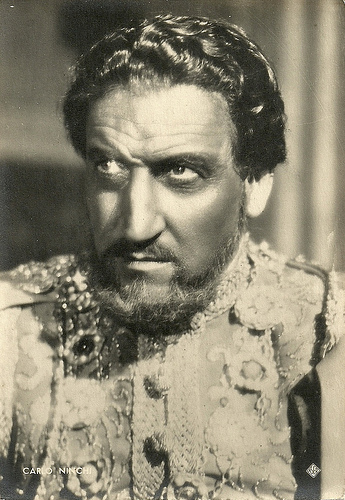
Italian postcard by ASER (A. Scaramaglia Edizioni, Roma), no. 33. Photo: Scalera Film / Foto Pesce.
Sources: Wikipedia (Italian and English), and .

Italian postcard by B.F.F. Edit (Ballerini & Fratini Editori), Firenze, no. 4452-A. Photo: Pesce / Scalera Film. Carlo Ninchi in Giarabub (Goffredo Alessandrini, 1942).
Great productive resources and a supercast
Carlo Ninchi was born in Bologna, Italy in 1896.
He debuted in the theatre company of his brother Annibale Ninchi , as Pilades in Alfieri’s Orestes. From then on, he was engaged by the major Italian stage companies, where he shared the stage with such other future great actors as Paolo Stoppa and Gino Cervi .
From the start of the Italian sound cinema in 1930 he acted in films. He alternated leads with supporting parts, starting with Corte d’Assise/Before the Jury (Guido Brignone 1930) with Marcella Albani . It was followed by Terra madre/Mother Earth (Alessandro Blasetti, 1931) with Leda Gloria .
He was Hagenbach opposite Germana Paolieri ’s Wally in La Wally (Guido Brignone, 1931), and Compare Alfio in Cavalleria rusticana (Amleto Palermi, 1939), both films based on famous operas. In the latter film he acted opposite Isa Pola and the sex symbol of the fascist regime, Doris Duranti .
Also in 1939 he acted in Mario Soldati’s romantic comedy Dora Nelson as a rich industrial whose runaway wife, a spoiled actress, is substituted on the set but also in private by a lookalike (a double role by Assia Noris ). The husband finally dumps his diva and marries the simple girl.
During the war years Ninchi, who had already acted in the fascist propaganda film Camicia nera/Black Shirt (Giovacchino Forzano, 1933), alternated propaganda films such as the colonial film Giarabub (Goffredo Alessandrini, 1942) and the anti-Soviet film Odessa in fiamme/Odessa in Flames (Carmine Gallone, 1942) with modern drama, romantic comedy and historical films, such as Catene invisibili/Invisible Chains (Mario Mattoli, 1942) and Stasera niente di nuovo/Nothing New Tonight (Mario Mattoli, 1942), both starring Alida Valli .
Ninchi acted opposite Maria Mercader in La porta del cielo/Heaven's Gate (Vittorio De Sica, 1945) and opposite Elio Parvo in Roberto Rossellini’s Desiderio (1943-46). Ninchi also played the tormented ‘Innominato’ in the Manzoni adaptation I promessi sposi/The Spirit and the Flesh (1941), directed by Mario Camerini and staged with great productive resources (the Milan Duomo as it looked like in 1627 was reconstructed on the studio lot) and a supercast.

Italian postcard by S.A. Grafitalia, Milano (Milan), no. 10. Photo: Film Lux. Publicity still for I Promessi Sposi/The Spirit and the Flesh (Mario Camerini, 1941) with Carlo Ninchi as L'Innominato.
Unforgettable comical personifications
In the later 1940s Carlo Ninchi was still highly active, for example in dramas with Clara Calamai such as L'adultera/The Adultress (Duilio Coletti, 1946) and Ultimo amore/Last Love (Mario Camerini, 1947). He also appeared opposite Rossano Brazzi and Valentina Cortese in Il passatore/The Ferryman (Duilio Coletti, 1947), which was co-written by Federico Fellini.
He also acted in comedies with Macario and Silvana Pampanini , such as Bellezze in bicicletta/Beauties on Bikes (Carlo Campogalliani, 1950), and in René Clair's fantasy film La beauté du diable/Beauty and the Devil (1950). In Camicie rosse/Red Shirts (Goffredo Alessandrini, Francesco Rosi, 1952), a biopic on Anita Garibaldi ( Anna Magnani ), Ninchi played the Italian revolutionary nationalist Ciceruacchio.
But perhaps Ninchi reached his highest peak after the war as Dante’s Count Ugolino in the homonymous film Il conte Ugolino/Count Ugolino (Riccardo Freda, 1949). Ninchi was always at ease in dramatic interpretations which permitted him to excel in his robust theatrical formation.
Ninchi also acted in the epic films Fabiola (Alessandro Blasetti, 1948), Messalina (Carmine Gallone, 1951), and Spartaco/Spartacus the Gladiator (Riccardo Freda, 1953), starring Massimo Girotti . Unforgettable are also his comical personifications in which he even parodied himself, in the first place his Pepè Le Mokò in the delicious Totò le Mokò (Carlo Ludovico Bragaglia, 1949).
From the 1950s the artistic value of his interpretations went down, apart from the TV series Il conte di Montecristo/The Count of Monte Cristo (Edmo Fenoglio, 1966) and La ciociara/Two Women (Vittorio De Sica, 1960) in which he played Jean-Paul Belmondo ’s father.
Carlo Ninchi died in Rome in 1974. His nephew Alessandro, born 1935, also followed a career as actor before stepping over to direction.

Italian postcard by ASER (A. Scaramaglia Edizioni, Roma), no. 33. Photo: Scalera Film / Foto Pesce.
Sources: Wikipedia (Italian and English), and .
Published on August 03, 2016 22:00
August 2, 2016
Es fiel ein Reif in der Frühlingsnacht (1915)
One of the most popular film stars of the German cinema in the 1910s and early 1920s was the American actress Fern Andra (1893-1974). She often co-directed and scripted her own films. A typical example is the melodrama Es fiel ein Reif in der Frühlingsnacht/There was frost in the spring night (Fern Andra, Kurt Matull, 1915), produced by Kurt Matull Film and Fern Andra Atelier.
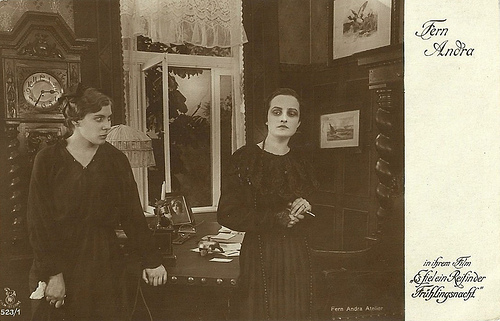
German postcard by Rotophot in the Film Sterne Series, no. 523/1. Photo: Fern Andra Atelier. Publicity still for Es fiel ein Reif in der Frühlingsnacht/There was frost in the spring night (Fern Andra, Kurt Matull, 1915) with Fern Andra .
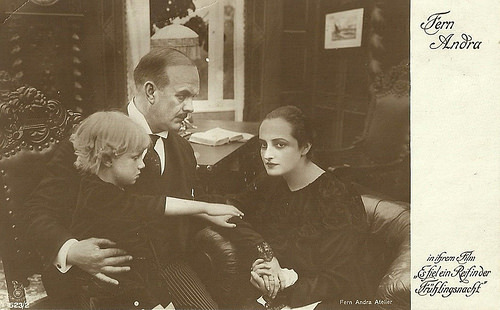
German postcard by Rotophot in the Film Sterne Series, no. 523/2. Photo: Fern Andra Atelier. Publicity still for Es fiel ein Reif in der Frühlingsnacht/There was frost in the spring night (Fern Andra, Kurt Matull, 1915).
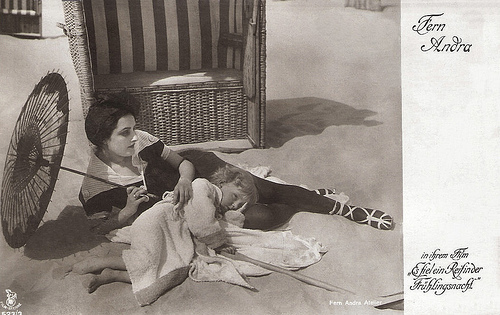
German postcard by Rotophot in the Film Sterne Series, no. 523/3. Photo: Fern Andra Atelier. Publicity still for Es fiel ein Reif in der Frühlingsnacht/There was frost in the spring night (Fern Andra, Kurt Matull, 1915).
A happy and harmonious marriage destroyed
In Es fiel ein Reif in der Frühlingsnacht/There was frost in the spring night (Fern Andra, Kurt Matull, 1915), Fern Andra plays the wife of bank director Balten. She has a happy and harmonious marriage with her husband, crowned by their son.
Hans Berndt, a friend of her husband, disrupts this happy bond by clumsily courting her. When visiting the seaside with her son, Berndt is present as well and starts to annoy her with his declarations of love. Unluckily Balten witnesses one of those attempts and calls Berndt to a duel.
Balten is shot, and soon after he dies of a severe wound. Berndt, unaware of the death of his duelling adversary, visits Ms. Balten and asks to be pardoned for his bad behaviour lately. She leads him to the corpse of her husband and accuses him of destroying her happiness.
Shocked, Berndt commits suicide with a gun, but by an unfortunate course of events, Ms Balten is suspected of having killed him. She is trialed, but on the day of the ordeal Berndt's farewell letter is found in the garden. Ms. Balten is acquitted and finds in her lawyer, who so well defended her, a new love and happiness.
Es fiel ein Reif in der Frülingsnacht, scripted by Fern Andra herself, was a typical example of Andra's melodramas that were so beloved in Germany during the First World War. These melodramas were situated either in aristocratic circles or in the world of the circus.
The press show of the film took place at the Berlin Mozartsaal on 21 October 1915. From 29 October it was released for public showings.
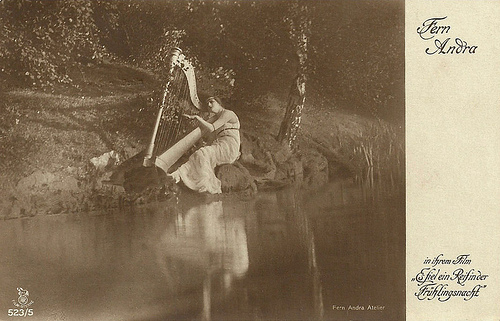
German postcard by Rotophot in the Film Sterne series, no. 523/5 Photo: Fern Andra Atelier. Fern Andra in Es fiel ein Reif in der Frühlingsnacht/There was frost in the spring night (Fern Andra, Kurt Matull, 1915).
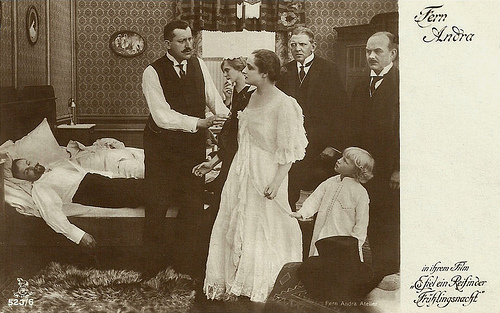
German postcard by Rotophot in the Film Sterne series, no. 523/6. Photo: Fern Andra Atelier. Fern Andra in Es fiel ein Reif in der Frühlingsnacht/There was frost in the spring night (Fern Andra, Kurt Matull, 1915).
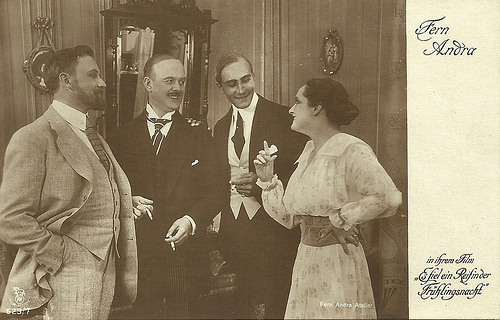
German postcard by Rotophot in the Film Sterne series, no. 523/7. Photo: Fern Andra Atelier. Fern Andra and Ferdinand Robert in Es fiel ein Reif in der Frühlingsnacht/There was frost in the spring night (Fern Andra, Kurt Matull, 1915).
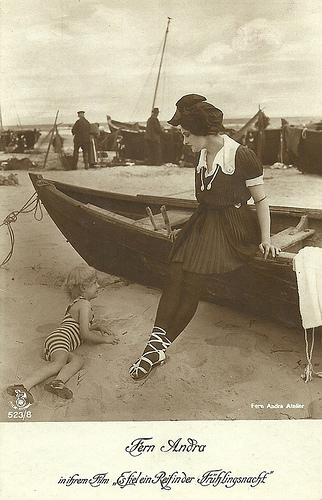
German postcard by Rotophot in the Film Sterne Series, no. 523/8. Photo: Fern Andra Atelier. Publicity still for Es fiel ein Reif in der Frühlingsnacht/There was frost in the spring night (Fern Andra, Kurt Matull, 1915). Collection: Didier Hanson.
Sources: Wikipedia (German) and IMDb.

German postcard by Rotophot in the Film Sterne Series, no. 523/1. Photo: Fern Andra Atelier. Publicity still for Es fiel ein Reif in der Frühlingsnacht/There was frost in the spring night (Fern Andra, Kurt Matull, 1915) with Fern Andra .

German postcard by Rotophot in the Film Sterne Series, no. 523/2. Photo: Fern Andra Atelier. Publicity still for Es fiel ein Reif in der Frühlingsnacht/There was frost in the spring night (Fern Andra, Kurt Matull, 1915).

German postcard by Rotophot in the Film Sterne Series, no. 523/3. Photo: Fern Andra Atelier. Publicity still for Es fiel ein Reif in der Frühlingsnacht/There was frost in the spring night (Fern Andra, Kurt Matull, 1915).
A happy and harmonious marriage destroyed
In Es fiel ein Reif in der Frühlingsnacht/There was frost in the spring night (Fern Andra, Kurt Matull, 1915), Fern Andra plays the wife of bank director Balten. She has a happy and harmonious marriage with her husband, crowned by their son.
Hans Berndt, a friend of her husband, disrupts this happy bond by clumsily courting her. When visiting the seaside with her son, Berndt is present as well and starts to annoy her with his declarations of love. Unluckily Balten witnesses one of those attempts and calls Berndt to a duel.
Balten is shot, and soon after he dies of a severe wound. Berndt, unaware of the death of his duelling adversary, visits Ms. Balten and asks to be pardoned for his bad behaviour lately. She leads him to the corpse of her husband and accuses him of destroying her happiness.
Shocked, Berndt commits suicide with a gun, but by an unfortunate course of events, Ms Balten is suspected of having killed him. She is trialed, but on the day of the ordeal Berndt's farewell letter is found in the garden. Ms. Balten is acquitted and finds in her lawyer, who so well defended her, a new love and happiness.
Es fiel ein Reif in der Frülingsnacht, scripted by Fern Andra herself, was a typical example of Andra's melodramas that were so beloved in Germany during the First World War. These melodramas were situated either in aristocratic circles or in the world of the circus.
The press show of the film took place at the Berlin Mozartsaal on 21 October 1915. From 29 October it was released for public showings.

German postcard by Rotophot in the Film Sterne series, no. 523/5 Photo: Fern Andra Atelier. Fern Andra in Es fiel ein Reif in der Frühlingsnacht/There was frost in the spring night (Fern Andra, Kurt Matull, 1915).

German postcard by Rotophot in the Film Sterne series, no. 523/6. Photo: Fern Andra Atelier. Fern Andra in Es fiel ein Reif in der Frühlingsnacht/There was frost in the spring night (Fern Andra, Kurt Matull, 1915).

German postcard by Rotophot in the Film Sterne series, no. 523/7. Photo: Fern Andra Atelier. Fern Andra and Ferdinand Robert in Es fiel ein Reif in der Frühlingsnacht/There was frost in the spring night (Fern Andra, Kurt Matull, 1915).

German postcard by Rotophot in the Film Sterne Series, no. 523/8. Photo: Fern Andra Atelier. Publicity still for Es fiel ein Reif in der Frühlingsnacht/There was frost in the spring night (Fern Andra, Kurt Matull, 1915). Collection: Didier Hanson.
Sources: Wikipedia (German) and IMDb.
Published on August 02, 2016 22:00
Paul van Yperen's Blog
- Paul van Yperen's profile
- 13 followers
Paul van Yperen isn't a Goodreads Author
(yet),
but they
do have a blog,
so here are some recent posts imported from
their feed.



